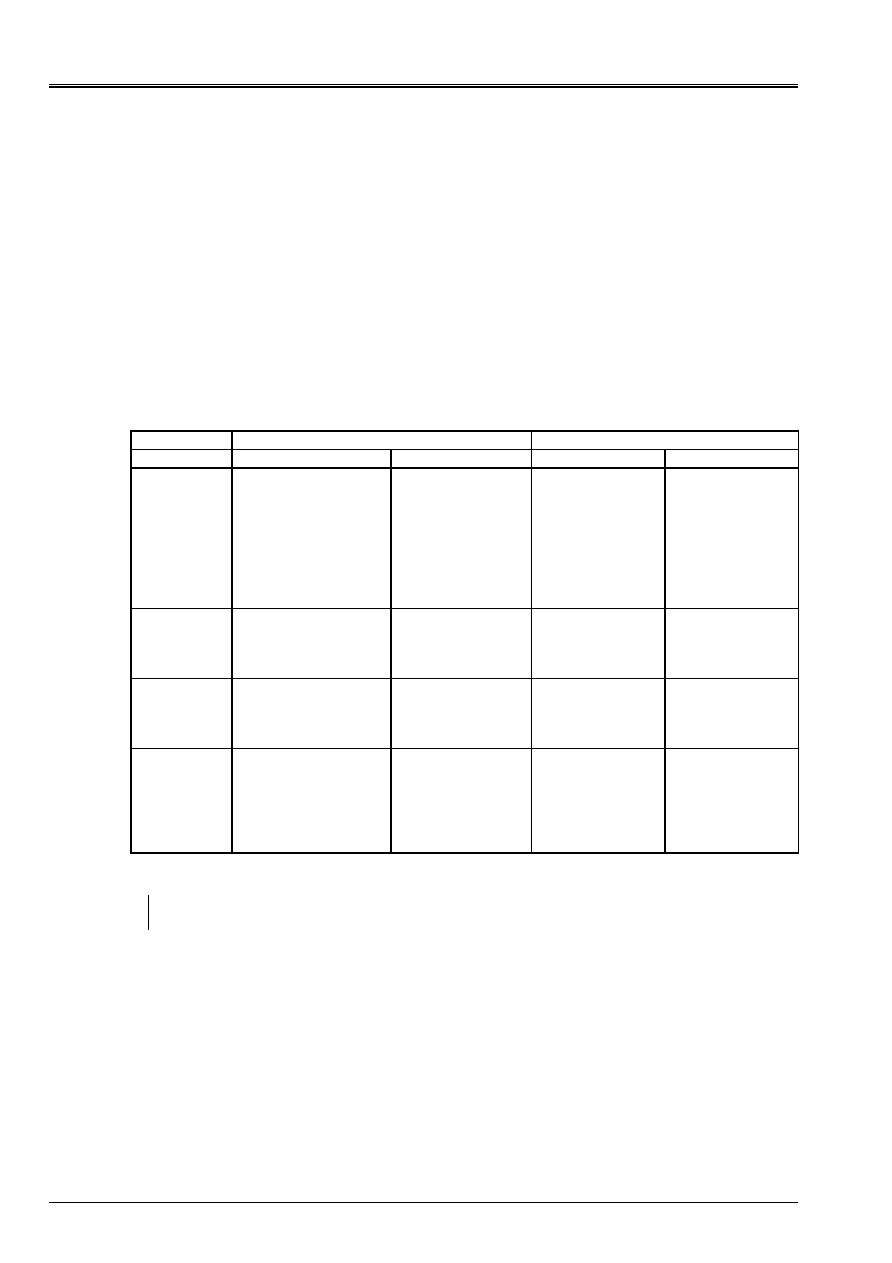
Code_Aster
®
Version
8.2
Titrate:
Nonlinear behaviors
Date
:
31/01/06
Author (S):
J.M. PROIX
Key
:
U4.51.11-B1
Page:
1/46
Instruction manual
U4.5- booklet: Method of resolution
HT-62/06/004/A
Organization (S):
EDF-R & D/AMA
Instruction manual
U4.5- booklet: Method of resolution
Document: U4.51.11
Nonlinear behaviors
1 Goal
One describes here the nonlinear behaviors of Code_Aster, introduced into the operators
STAT_NON_LINE, DYNA_NON_LINE, or DYNA_TRAN_EXPLI, via the key words
COMP_INCR or COMP_ELAS.

Code_Aster
®
Version
8.2
Titrate:
Nonlinear behaviors
Date
:
31/01/06
Author (S):
J.M. PROIX
Key
:
U4.51.11-B1
Page:
2/46
Instruction manual
U4.5- booklet: Method of resolution
HT-62/06/004/A
Count
matters

Code_Aster
®
Version
8.2
Titrate:
Nonlinear behaviors
Date
:
31/01/06
Author (S):
J.M. PROIX
Key
:
U4.51.11-B1
Page:
3/46
Instruction manual
U4.5- booklet: Method of resolution
HT-62/06/004/A
2 Syntax
| COMP_INCR = _F (
RELATION
=/
“VMIS_ISOT_TRAC”,
[DEFECT]
/…
/
other relations [§ 3.3.1],
/…
RELATION_KIT=
/“ELAS”,
/…
/
other relations [§ 3.3.2],
/…
DEFORMATION
=
/
“SMALL”, [DEFECT]
/
“PETIT_REAC”,
/
“SIMO_MIEHE”,
/
“GREEN”,
/
“GREEN_GR”,
/
ALL
=
“YES”,
[DEFECT]
/
|
GROUP_MA=
lgrma,
[l_gr_maille]
|
NET
=
lma, [l_maille]
ALGO_C_PLAN
=
/
“ANALYTICAL”
[DEFECT]
/“DEBORST”
ALGO_1D =
/“ANALYTICAL”
[DEFECT]
/“DEBORST”
),
| COMP_ELAS
=_F
(
RELATION
=/
“ELAS”,
[DEFECT]
/…
/
other relations [§ 3.4.1],
/…
DEFORMATION
=
/
'SMALL,
[DEFECT]
/
“GREEN”,
/
“GREEN_GR”,
/
ALL
=
“YES”
[DEFECT]
/
|
GROUP_MA=
lgrma
[l_gr_maille]
|
NET
= lma
[l_maille]
),
RESI_INTE_RELA
=
/
1.E-6,
[DEFECT]
/
resint,
[R]
ITER_INTE_MAXI
=
/
10,
[DEFECT]
/
iteint,
[I]
ITER_INTE_PAS
=
/
0, [DEFECT]
/
itepas,
[I]
RESO_INTE
=
/
“IMPLICIT”,
[DEFECT]
/
“RUNGE_KUTTA_2”,
/
“RUNGE_KUTTA_4”,

Code_Aster
®
Version
8.2
Titrate:
Nonlinear behaviors
Date
:
31/01/06
Author (S):
J.M. PROIX
Key
:
U4.51.11-B1
Page:
4/46
Instruction manual
U4.5- booklet: Method of resolution
HT-62/06/004/A
3 Operands
3.1 Word
key
COMP_INCR
|
COMP_INCR:
This key word factor makes it possible to define the relations of behavior for which history
material influences its behavior: majority of the laws of behavior (in particular
in plasticity) are written in an incremental way then. The history seen by material is stored
in the internal variables. One can have in same calculation certain parts of
structure obeying with various incrémentaux behaviors (COMP_INCR) and other parts
obeying various elastic behaviors (COMP_ELAS).
Certain models of behaviors were not developed in plane stress.
However, the key word
ALGO_C_PLAN
[§3.3.5] allows to add this condition to all them
models: the algorithm called
“DEBORST”
a taking into account of the assumption allows of
plane stresses on the level of the algorithm of balance (contrary to the models of
behavior developed explicitly
“ANALYTICAL”
in the language Aster - in
plane stresses, which adopt this approach on the level of the integration of the laws of
behavior). One can thus also assign a nonlinear law to the elements of
structure DKT, COQUE_3D and PIPE.
In the same way, for the uses using a monodimensional state of stresses (POU_D_EM,
POU_D_TGM, GRILL_MEMBRANE, BAR), to be able to use the behaviors 3D, it is necessary
to use key word ALGO_1D (METHOD = “DEBORST”).
3.1.1 Operand
RELATION
RELATION:
# Model conventional
/
“ELAS”
/
“VMIS_ISOT_TRAC”
[DEFECT]
/
“VMIS_ISOT_LINE”
/
“VISC_ISOT_TRAC”
/
“VISC_ISOT_LINE”
/
“VMIS_CINE_LINE”
/
“VMIS_ECMI_TRAC”
/
“VMIS_ECMI_LINE”
/
“LEMAITRE”
/
“CHABOCHE”
/
“VISC_CIN1_CHAB”
/
“VISC_CIN2_CHAB”
/
“NORTON_HOFF”
/
“CZM_EXP_REG”
/
“CZM_EXP”
/
“ZMAT”
# Model buildings with damage (see also behavior for
concrete)
/
“ENDO_FRAGILE”
/
“ENDO_ISOT_BETON”
/
“ENDO_ORTH_BETON”
/
“ROUSSELIER”
/
“ROUSS_PR”
/
“ROUSS_VISC”
/
“VENDOCHAB”
# Model treaties in formulation not room
/
“ENDO_FRAGILE”
/
“ENDO_ISOT_BETON”
/
“ENDO_ORTH_BETON”
/
“RUPT_FRAG”
/
“VMIS_ISOT_TRAC”
/
“VMIS_ISOT_LINE”

Code_Aster
®
Version
8.2
Titrate:
Nonlinear behaviors
Date
:
31/01/06
Author (S):
J.M. PROIX
Key
:
U4.51.11-B1
Page:
5/46
Instruction manual
U4.5- booklet: Method of resolution
HT-62/06/004/A
/
“DRUCKER_PRAGER”
/
“MAZARS”
/
“ROUSSELIER”
# Model describing the progressive deformation
/
“VISC_TAHERI”
/
“POLY_CFC”
# Model describing the behavior of microstructures
/
“MONOCRYSTAL”
/
“POLYCRYSTAL”
# Behaviors specific to the pencils AND FUEL ASSEMBLIES
/
“LMARC”
/
“ZIRC_CYRA2”
/
“ZIRC_EPRI”
/
“LEMAITRE_IRRA”
/
“GRAN_IRRA_LOG”
/
“VISC_IRRA_LOG”
/
“GATT_MONNERIE”
# Behaviors specific to the elements of beams and discrete
/
“DIS_CONTACT”
/
“DIS_GRICRA”
/
“DIS_CHOC”
/
“VMIS_POU_LINE”
/
“VMIS_POU_FLEJOU”
/
“WEAPON”
/
“ASSE_CORN”
/
“DIS_GOUJ 2e_PLAS”
/
“DIS_GOUJ 2e_ELAS”
/
“VMIS_ASYM_LINE”
/
“CORR_ACIER”
/
“LMARC_IRRA”
# Model mechanical with effects of the metallurgical transformations
/
“META_P_IL”
/
“META_P_INL”
/
“META_P_IL_PT”
/
“META_P_INL_PT”
/
“META_P_IL_RE”
/
“META_P_INL_RE”
/
“META_P_IL_PT_RE”
/
“META_P_INL_PT_RE”
/
“META_P_CL”
/
“META_P_CL_PT”
/
“META_P_CL_RE”
/
“META_P_CL_PT_RE”
/
“META_V_IL”
/
“META_V_INL”
/
“META_V_IL_PT”
/
“META_V_INL_PT”
/
“META_V_IL_RE”
/
“META_V_INL_RE”
/
“META_V_IL_PT_RE”
/
“META_V_INL_PT_RE”
/
“META_V_CL”
/
“META_V_CL_PT”
/
“META_V_CL_RE”
/
“META_V_CL_PT_RE”
# Behaviors for the concrete
/
“BETON_DOUBLE_DP”
/
“MAZARS”
/
“LABORD_1D'
/
“JOINT_BA”
/
“GRILL_ISOT_LINE”
/
“GRILL_CINE_LINE”

Code_Aster
®
Version
8.2
Titrate:
Nonlinear behaviors
Date
:
31/01/06
Author (S):
J.M. PROIX
Key
:
U4.51.11-B1
Page:
6/46
Instruction manual
U4.5- booklet: Method of resolution
HT-62/06/004/A
/
“GRILL_PINTO_MEN”
/“PINTO_MENEGOTTO”
/
“GLRC”
/
“GRANGER_FP”
/
“GRANGER_FP_INDT”
/
“GRANGER_FP_V”
/
“BAZANT_FD”
/
“BETON_UMLV_FP”
/
“KIT_DDI”
/
“CORR_ACIER”
# Behaviors for the porous environments and the grounds
/
“KIT_HM”
/
“KIT_THM”
/
“KIT_HHM”
/
“KIT_THH”
/
“KIT_THHM”
/
“KIT_THV”
/
“CJS”
/
“DRUCKER_PRAGER”
/
“LAIGLE”
/
, HOEK_BROWN'
/
“ELAS_THM”
/
“CAM_CLAY”
/
“BARCELONA”

Code_Aster
®
Version
8.2
Titrate:
Nonlinear behaviors
Date
:
31/01/06
Author (S):
J.M. PROIX
Key
:
U4.51.11-B1
Page:
7/46
Instruction manual
U4.5- booklet: Method of resolution
HT-62/06/004/A
Small dictionary of the modelings supported by the laws of nonlinear behavior
Not to overload this document, we will invite thereafter:
·
Modeling
3D
= modelings
3D
and
3d_SI
·
Modeling
D_PLAN
= modelings
D_PLAN
and
D_PLAN_SI
·
Modeling
AXIS
= modelings
AXIS
and
AXIS_SI
·
Modeling
C_PLAN
= modelings
C_PLAN
and
C_PLAN_SI
·
Modeling
HULL
= modelings
COQUE_3D
and
DKT
·
Modeling
PIPE
= modelings
TUYAU_3M
and
TUYAU_6M
·
Modeling
COQUE1D
= modelings
COQUE_AXIS
,
COQUE_C_PLAN
and
COQUE_D_PLAN
·
Modeling
3d_DIS
= modelings
DIS_T
and
DIS_TR
·
Modeling
2d_DIS
= modelings
2d_DIS_T
and
2d_DIS_TR
·
Modeling
ROAST
= modelings
ROAST
and GRILL_MEMBRANE
·
Modeling
INCO
= modelings
3d_INCO
,
AXIS_INCO
and
D_PLAN_INCO
·
Modeling
LOUSE
·
Modeling PMF
=
=
modelings
POU_D_E
,
POU_D_T
,
POU_D_TG
,
POU_D_EM
and
POU_D_TGM
·
Modeling
BAR
= modeling
BAR
and
2d_BARRE
·
Modeling
THM
= modelings
3d_HHM
,
3d_HM
,
3d_JOINT_CT
,
3d_THH
,
3d_THHM
,
3d_THM
,
3d_HHMD
,
3d_HMD
,
3d_THHD
,
3d_THHMD
,
3d_THMD
,
3d_THVD
,
AXIS_HHM
,
AXIS_HM
,
AXIS_THH
,
AXIS_THHM
,
AXIS_THM
,
AXIS_HHMD
,
AXIS_HH2MD
,
AXIS_HMD
,
AXIS_THHD
,
AXIS_THH 2D
,
AXIS_THHMD
,
AXIS_THH2MD
,
AXIS_THMD
,
AXIS_THVD
,
D_PLAN_HHM
,
D_PLAN_HM
,
D_PLAN_THH
,
D_PLAN_THHM
,
D_PLAN_THM
,
D_PLAN_HHMD
,
D_PLAN_HH2MD
,
D_PLAN_HMD
,
D_PLAN_THHD
,
D_PLAN_THH 2D
,
D_PLAN_THHMD
,
D_PLAN_THH2MD
,
D_PLAN_THMD
and
D_PLAN_THVD
·
Modeling
GRAD_EPSI
= modelings
3d_GRAD_EPSI
,
D_PAN_GRAD_EPSI
and
C_PLAN_GRAD_EPSI
·
Modeling
GRAD_VARI
= modelings
3d_GRAD_VARI
,
D_PAN_GRAD_VARI
,
C_PLAN_GRAD_VARI
and
AXIS_GRAD_VARI
·
Modeling
FISSURE
PLAN_FISSURE
,
AXIS_FISSURE
Note:
If a law of behavior is used with one of modelings
INCO
(for
incompressible), it is necessary to use only the tangent matrix (key word factor
PREDICTION=' TANGENTE'
and
MATRICE=' TANGENTE'
under
NEWTON
STAT_NON_LINE
[U4.51.03] and DYNA_NON_LINE [U4.53.01]). In the contrary case, one stops in fatal error.
Note:
Thereafter, one will give, for each law of behavior, the number of variables
interns stored under
VARI_ELGA
and their significance (if this number is not too large).
For the precise significance of these various relations one will refer to various documentations
of Reference like to the documentation of DEFI_MATERIAU.

Code_Aster
®
Version
8.2
Titrate:
Nonlinear behaviors
Date
:
31/01/06
Author (S):
J.M. PROIX
Key
:
U4.51.11-B1
Page:
8/46
Instruction manual
U4.5- booklet: Method of resolution
HT-62/06/004/A
3.1.1.1 Models
conventional
Unless otherwise specified, all the models can include a dependence compared to
temperature.
/“ELAS”
Relation of elastic behavior incremental: it makes it possible to take into account
initial displacements and stresses given under the key word
ETAT_INIT
. Data
necessary of the field material are provided in the operator
DEFI_MATERIAU
[U4.43.01], under
the key word
ELAS
(
_FO
).
Supported modelings:
3D
,
D_PLAN
,
AXIS
,
C_PLAN
,
HULL
,
PIPE
,
COQUE1D
,
3d_DIS
,
2d_DIS
,
INCO
,
LOUSE
,
BAR
, PMF, GRID.
A number of internal variables: 1
Significance: V1: vacuum thus is worth always zero (with the deformations of the type
SIMO_MIEHE
only cf [§3.3.3], V1 is equal to the trace of the tensor of elastic strain divided by
3 used for the formulation
SIMO_MIEHE
).
/“VMIS_ISOT_TRAC”
Relation of behavior of elastoplasticity of Von Mises with nonlinear isotropic work hardening.
The curve
(
,
)
in simple traction is provided in the operator
DEFI_MATERIAU
[U4.43.01], under
the key word
TRACTION
(Cf [R5.03.02] for more details). One can possibly define
several traction diagrams according to the temperature. One must also inform the key word
ELAS (_FO)
in the operator
DEFI_MATERIAU
. It is the relation of behavior per defect for
incrémentaux behaviors.
If a traction diagram is provided, the YOUNG modulus used for the relation of
behavior is that calculated starting from the first point of the traction diagram, that used for
the calculation of the elastic matrix (see key word NEWTON [U4.51.03]) is that given in
ELAS (_FO
).
Supported modelings:
3D
,
D_PLAN
,
AXIS
,
C_PLAN
,
HULL
,
PIPE
,
COQUE1D
,
BAR
,
PMF
and
INCO
.
A number of internal variables: 2
Significance: V1: cumulated plastic deformation, V2: indicator of plasticity (0 for rubber band,
1 for plastic). With the deformations of the type
SIMO_MIEHE
only (cf [§3.3.3]), one
internal variable additional V3: trace tensor of elastic strain divided by
3 used for the formulation
SIMO_MIEHE
.
Supported nonlocal modeling (see [§ 3.3.1.3]):
GRAD_VARI
/“VMIS_ISOT_LINE”
Relation of behavior of elastoplasticity of Von Mises with linear isotropic work hardening.
data necessary of the field material are provided in the operator
DEFI_MATERIAU
[U4.43.01] under the key words
ECRO_LINE
(
_FO)
and
ELAS (_FO)
(Cf [R5.03.02]).
Supported modelings:
3D
,
D_PLAN
,
AXIS
,
C_PLAN
,
HULL
,
PIPE
,
COQUE1D
,
INCO
, PMF and
BAR
.
A number of internal variables: 2
Significance (except modeling
BAR
): V1: cumulated plastic deformation, V2: indicator of
plasticity (0 for rubber band, 1 for plastic). With the deformations of the type
SIMO_MIEHE
only (cf [§3.3.3]), an internal variable additional V3: trace tensor of
elastic strain divided by 3 used for the formulation
SIMO_MIEHE
.
Supported nonlocal modeling (see [§ 3.3.1.3]):
GRAD_VARI

Code_Aster
®
Version
8.2
Titrate:
Nonlinear behaviors
Date
:
31/01/06
Author (S):
J.M. PROIX
Key
:
U4.51.11-B1
Page:
9/46
Instruction manual
U4.5- booklet: Method of resolution
HT-62/06/004/A
/“VISC_ISOT_LINE”
Visco-elastoplastic relation of behavior in great deformations (formulation
SIMO_MIEHE only). The plastic model is VMIS_ISOT_LINE i.e. with work hardening
isotropic linear. The data necessary of the field material are provided in the operator
DEFI_MATERIAU [U4.43.01] under key words ECRO_LINE (_FO), ELAS (_FO).
The law of viscosity is a hyperoblic law in sine (cf [R5.03.21]. The viscous parameters are
to inform under key word VISC_SINH in operator DEFI_MATERIAU.
Supported modelings: 3D, D_PLAN, AXIS and INCO.
A number of internal variables: 3
Significance: V1: cumulated plastic deformation, V2: indicator of plasticity (0 for rubber band,
1 for plastic), V3: trace tensor of elastic strain divided by 3 used for
formulation SIMO_MIEHE.
/“VISC_ISOT_TRAC”
Visco-elastoplastic relation of behavior in great deformations (formulation
SIMO_MIEHE only). The plastic model is VMIS_ISOT_TRAC i.e. with work hardening
isotropic nonlinear. The curve (
,) in simple traction is provided in the operator
DEFI_MATERIAU [U4.43.01], under the key word TRACTION (cf [R5.03.02] for more details). One
can possibly define several traction diagrams according to the temperature. One must
also to inform key word ELAS (_FO) in operator DEFI_MATERIAU.
The law of viscosity is a law in hyperbolic sine (cf [R5.03.21]. The viscous parameters are
to inform under key word VISC_SINH in operator DEFI_MATERIAU.
Supported modelings: 3D, D_PLAN, AXIS and INCO.
A number of internal variables: 3
Significance: V1: cumulated plastic deformation, V2: indicator of plasticity (0 for rubber band,
1 for plastic), V3: trace tensor of elastic strain divided by 3 used for
formulation SIMO_MIEHE.
/“VMIS_CINE_LINE”
Relation of behavior of elastoplasticity of Von Mises with linear kinematic work hardening.
The data necessary of the field material are provided in the operator
DEFI_MATERIAU
[U4.43.01], under the key words
ECRO_LINE
(
_FO)
and
ELAS (_FO)
(Cf [R5.03.02] for more
details).
Supported modelings:
3D
,
D_PLAN
,
AXIS
,
C_PLAN
(by
DEBORST
, key word
ALGO_C_PLAN
[§3.3.5]),
HULL
,
PIPE
,
COQUE1D
,
INCO
,
BAR
and PMF.
A number of variables intern (except modelings
BAR
and
PMF
): 7
Significance: V1 with V6: 6 components of the kinematic tensor of work hardening X, V7: indicator
of plasticity (0 for rubber band, 1 for plastic).
A number of variables intern for modeling
BAR
: 2
Significance: V1: kinematic work hardening X.
V2: indicator of plasticity
/“VMIS_ECMI_TRAC”
Relation of behavior of elastoplasticity of Von Mises with combined, kinematic work hardening
linear and isotropic nonlinear (cf [R5.03.02] for more details). Isotropic work hardening is
given by a traction diagram (
,) or possibly by several curves if those Ci
depend on the temperature. The characteristics of material are provided in the operator
DEFI_MATERIAU
[U4.43.01], under the key words
PRAGER (_FO)
(for kinematic work hardening),
TRACTION
(for isotropic work hardening) and
ELAS
(
_FO)
.
Supported modelings:
3D
,
D_PLAN
,
AXIS
,
C_PLAN
,
INCO
,
HULL
,
PIPE
and
COQUE1D
(by
DEBORST key word ALGO_1D: modelings BARS, PMF, GRID).
A number of internal variables: 8

Code_Aster
®
Version
8.2
Titrate:
Nonlinear behaviors
Date
:
31/01/06
Author (S):
J.M. PROIX
Key
:
U4.51.11-B1
Page:
10/46
Instruction manual
U4.5- booklet: Method of resolution
HT-62/06/004/A
Significance: V1: cumulated plastic deformation, V2: indicator of plasticity (0 for rubber band,
1 for plastic), V3 with V8: 6 components of the kinematic tensor of work hardening X.
/“VMIS_ECMI_LINE”
Relation of behavior of elastoplasticity of Von Mises with combined, kinematic work hardening
linear and isotropic linear (cf [R5.03.02] for more details). Characteristics of material
are provided in the operator
DEFI_MATERIAU
[U4.43.01], under the key words
PRAGER (_FO)
(for kinematic work hardening),
ECRO_LINE
(
_FO)
(
for isotropic work hardening) and
ELAS (_FO)
.
Supported modelings:
3D
,
D_PLAN
,
AXIS
,
C_PLAN
,
INCO
,
HULL
,
PIPE
and
COQUE1D
(by
DEBORST key word ALGO_1D: modelings BARS, PMF, GRID).
A number of internal variables: 8
Significance: V1: cumulated plastic deformation, V2: indicator of plasticity (0 for rubber band,
1 for plastic), V3 with V8: 6 components of the kinematic tensor of work hardening X.
/
“LEMAITRE”
Relation of viscoplastic behavior nonlinear of Lemaitre (without threshold). A particular case
of this relation (by cancelling the parameter
UN_SUR_M
) a relation of NORTON gives.
data necessary of the field material are provided in the operator
DEFI_MATERIAU
[U4.43.01], under the key words
LEMAITRE (_FO)
and
ELAS (_FO)
(Cf [R5.03.08] for more
details). The correspondence of the internal variables allows the chaining with a calculation using one
elastoplastic behavior with isotropic work hardening (`
VMIS_ISOT_LINE
'or
`
VMIS_ISOT_TRAC
'). The integration of this model is carried out by an semi-implicit method
(coded into hard thus nothing to specify of private individual by the user).
Supported modelings:
3D
,
D_PLAN
,
AXIS
,
C_PLAN
(by
DEBORST
, key word
ALGO_C_PLAN
[§3.3.5]),
INCO
,
HULL
,
PIPE
,
COQUE1D
and
DEBORST
, key word
ALGO_1D
:
BAR
,
PMF
,
ROAST
.
A number of internal variables: 2
Significance: V1: cumulated plastic deformation, V2: vacuum thus is worth always 0.
/
“CHABOCHE”
Relation of behavior of Chaboche in isothermal elastoplasticity with 2 tensors
of nonlinear kinematic work hardening (without effect of work hardening on the term of recall) more one
isotropic work hardening. The data necessary of the field material are provided in the operator
DEFI_MATERIAU
[U4.43.01], under the key words
CHABOCHE
and
ELAS
(Cf [R5.03.04] for more
details). To facilitate the integration of this model, one can use local automatic recutting
pitch of time (see [§3.13.6], key word
ITER_INTE_PAS
).
Supported modelings:
3D
,
D_PLAN
,
AXIS
,
C_PLAN
,
INCO
,
HULL
,
PIPE
,
COQUE1D
(and by
DEBORST
, key word
ALGO_1D
:
PMF
,
BAR
,
ROAST
).
A number of internal variables: 14
Significance: V1 with V6: 6 components of the 1
er
tensor of kinematic work hardening X
1
, V7 with V12:
6 components of the 2
ème
kinematic tensor of work hardening X
2
, V13: plastic deformation
cumulated, V14: 1 is worth.
/
“VISC_CIN1_CHAB”
Relation of behavior of Chaboche (account of the cyclic behavior of material returns) in
élasto- (visco) - plasticity with a tensor of kinematic work hardening nonlinear, a work hardening
isotropic nonlinear, an effect of work hardening on the tensorial variable of recall and possibly
the taking into account of viscosity. All the constants of material possibly can
to depend on the temperature (contrary to
CHABOCHE
). Data necessary of the field
material are provided in the operator
DEFI_MATERIAU
[U4.43.01], under the key words
CIN1_CHAB (_F0)
,
ELAS (_FO)
(Cf [R5.03.04] for more details) and
LEMAITRE
if one holds
count viscosity (if there is no viscosity especially not to inform
LEMAITRE
). Integration is completely implicit.

Code_Aster
®
Version
8.2
Titrate:
Nonlinear behaviors
Date
:
31/01/06
Author (S):
J.M. PROIX
Key
:
U4.51.11-B1
Page:
11/46
Instruction manual
U4.5- booklet: Method of resolution
HT-62/06/004/A
Supported modelings:
3D
,
D_PLAN
,
AXIS
,
C_PLAN
(by
DEBORST
, key word
ALGO_C_PLAN
[§3.3.5]),
INCO
,
HULL
,
PIPE
,
COQUE1D
(and by
DEBORST
, key word
ALGO_1D
:
PMF
,
BAR
,
ROAST
).
A number of internal variables: 8
Significance: V1: cumulated plastic deformation, V2: indicator of plasticity (0 for rubber band,
1 for plastic), V3 with V8: 6 components of the kinematic tensor of work hardening X.
/
“VISC_CIN2_CHAB”
Relation of behavior of Chaboche (account of the cyclic behavior of material returns) in
élasto- (visco) - plasticity with 2 tensors of nonlinear kinematic work hardening, a work hardening
isotropic nonlinear, an effect of work hardening on the tensorial variable of recall and possibly
the taking into account of viscosity. All the constants of material possibly can
to depend on the temperature (contrary to
CHABOCHE
). Data necessary of the field
material are provided in the operator
DEFI_MATERIAU
[U4.43.01], under the key words
CIN2_CHAB (_F0
),
ELAS (_FO)
(Cf [R5.03.04] for more details) and
LEMAITRE
if one holds
count viscosity (if there is no viscosity especially not to inform
LEMAITRE
). Integration is completely implicit.
Supported modelings:
3D
,
D_PLAN
,
AXIS
,
C_PLAN
(by
DEBORST
, key word
ALGO_C_PLAN
[§3.3.5]),
INCO
,
HULL
,
PIPE
,
COQUE1D
(and by
ALGO_1D/DEBORST
:
PMF
,
BAR
,
ROAST
).
A number of internal variables: 14
Significance: V1: cumulated plastic deformation, V2: indicator of plasticity (0 for rubber band,
1 for plastic), V3 with V8: 6 components of the 1
er
tensor of the kinematic variable
1
, V9 with
V14: 6 components of the 2
ème
tensor of the kinematic variable
2
.
/
“NORTON_HOFF”
Relation of behavior of viscosity independent of the temperature, to use in particular for
the calculation of loads limit structures, with threshold of Von Mises. The only parameter material is
elastic limit to be informed in the operator
DEFI_MATERIAU
[U4.43.01] under the key word
ECRO_LINE
(Cf [R7.07.01] and [R5.03.12] for more details). For the calculation of the limiting load, it
exist a specific key word under PILOTING for this model (see key word
PILOTING:“ANA_LIM”
[§3.11]). It is strongly advised to employ linear search
(see key word
RECH_LINEAIRE
[§3.9]). Indeed, the calculation of the limiting load requires much
iterations of linear search (about 50) and of iterations of Newton (about 50).
Supported modeling:
INCO
.
A number of internal variables: 1
Significance: V1: vacuum thus is worth 0.
A number of internal variables: 2
Significance: V1: threshold corresponding to the greatest jump of displacement (in standard) never
reached, V2: indicator of cracking (0 for elastic mode, 1 for softening mode).
/“CZM_EXP_REG”
Cohesive relation of behavior (Cohesive Exponential Model Area Regularized) of type
Barenblatt (cf [R7.02.11] for more detail) modelizing the opening of a fissure. This law is
usable with the finite element of type gasket (cf [R3.06.09] for more detail) and allows to introduce
a force of cohesion enters the lips of the fissure. Data necessary of the field material
are provided in the operator
DEFI_MATERIAU
[U4.43.01], under the key word
RUPT_FRAG
.
The use of this model requires the presence of piloting by
PRED_ELAS
(cf [§3.11]).
Supported modeling:
PLAN_JOINT, AXIS_JOINT
.
A number of internal variables: 4
Significance: V1: threshold corresponding to the greatest jump of displacement (in standard) never
reached, V2: indicator of cracking (0 for linear mode, 1 for softening mode), V3:
indicator of the percentage of dissipated energy, V4: indicator being worth 2 if the lips are in contact
or 1 if there is separation.

Code_Aster
®
Version
8.2
Titrate:
Nonlinear behaviors
Date
:
31/01/06
Author (S):
J.M. PROIX
Key
:
U4.51.11-B1
Page:
12/46
Instruction manual
U4.5- booklet: Method of resolution
HT-62/06/004/A
/“CZM_EXP”
Cohesive relation of behavior (Cohesive Exponential Model Area) of Barenblatt type
(Cf [R7.02.12] for more detail) modelizing the opening of a fissure. This law is usable
with the finite element with internal discontinuity (cf [R7.02.12] for more detail) and allows to introduce
a force of cohesion enters the lips of the fissure. Data necessary of the field material
are provided in the operator
DEFI_MATERIAU
[U4.43.01], under the key word
RUPT_FRAG
.
The use of this model requires the presence of piloting by
PRED_ELAS
(cf [§3.11]).
Supported modeling:
PLAN_ELDI, AXIS_ELDI
.
A number of internal variables: 7
Significance: V1: normal jump, V2: tangential jump, V3: variable threshold, V4: indicator of
cracking (0 for linear mode, 1 for softening mode), V5: indicator of the percentage
of dissipated energy, V6: normal stress, V7: tangential stress.
/“ZMAT”
NB_VARI =
nbvar
UNIT
= links
ZMAT, is the module of definition of the behaviors of the code Zebulon (Center of Materials,
École Nationale Supérieure of the Mines of Paris) the coupling Zmat Code_Aster is translated for
the user of Code_Aster in the following way:
· on the level of COMP_INCR, key word RELATION=' ZMAT', to go to read the file
containing the data ZMAT (which allows at the same time the choice of the behavior and
definition of the coefficients material). This file can call upon a behavior already
available in Zmat, or well defined by the user in a relatively simple language
(Zebfront).
· always under COMP_INCR, a key word UNIT makes it possible to define the logical unit on which
comes to read to card-index it zmat and one have mot_clé NB_VARI making it possible to specify the number of
variables intern behavior, and of course the usual key words: GROUP_MA,
DEFORMATION (SMALL or PETIT_REAC for the moment), In ASTK, compared to one
conventional study, it is enough to add file ZMAT corresponding to the unit defined above.
The use of Zmat for Code_Aster is envisaged, within the framework of the partnership School of the Mines -
EDF, for calculations of R & D only, which excludes in particular in the version 8.2 them
studies IPS. Out of this framework, the license of Zmat can be acquired near the Center of
Materials of the ENSMP.
For more details, to see the document [U2.10.01] Note of use of the coupling Zmat-Aster
The documentation of use of ZMat is available on the machine of development
Alphaservor in the index/public aster//Z8.3/HANDBOOK

Code_Aster
®
Version
8.2
Titrate:
Nonlinear behaviors
Date
:
31/01/06
Author (S):
J.M. PROIX
Key
:
U4.51.11-B1
Page:
13/46
Instruction manual
U4.5- booklet: Method of resolution
HT-62/06/004/A
3.1.1.2 Local models with damage
Caution:
The response of a model of local behavior with damage is dependant on
mesh.
/“ENDO_FRAGILE”
Relation of elastic behavior fragile. It is about a local modeling with damage
scalar and with negative linear isotropic work hardening (cf [R5.03.18] for more details).
characteristics of material are defined in the operator
DEFI_MATERIAU
[U4.43.01] under
key words
ECRO_LINE (_FO)
(
DSDE
negative) and
ELAS
(
_FO)
.
Supported modelings:
3D
,
D_PLAN
,
AXIS
,
C_PLAN
,
INCO
,
HULL
,
PIPE
and
COQUE1D
.
A number of internal variables: 2
Significance: V1: value of the damage, V2: indicator of damage (0 if
the damage is worth 0, 1 if the damage is higher than 0).
Supported nonlocal modeling (see [§ 3.3.1.3]):
GRAD_VARI
and
GRAD_EPSI
.
/“ENDO_ISOT_BETON”
Relation of elastic behavior fragile. It is about a local modeling with damage
scalar and with negative linear isotropic work hardening which distinguishes behavior in traction and in
compression of the concrete (cf [R7.01.04] for more details). The characteristics of material are
defined in the operator
DEFI_MATERIAU
[U4.43.01] under the key words
BETON_ECRO_LINE
and
ELAS
.
Supported modelings:
3D
,
D_PLAN
,
AXIS
,
C_PLAN
(by
DEBORST
, key word
ALGO_C_PLAN
[§3.3.5]),
INCO
,
HULL
, PIPE, COQUE1D.
A number of internal variables: 2
Significance: V1: value of the damage, V2: indicator of damage (0 for mode
rubber band (null damage), 1 if damaged, 2 if broken (damage equal to 1)).
Supported nonlocal modeling (see [§ 3.3.1.3]):
GRAD_EPSI
/“ENDO_ORTH_BETON”
Relation of anisotropic behavior of the concrete with damage [R7.01.09]. It is about one
local modeling of fascinating damage of account refermeture of the fissures.
characteristics of materials are defined in operator DEFI_MATERIAU under the key words
ELAS and ENDO_ORTH_BETON.
Supported modelings: 3D, D_PLAN, AXIS (by DEBORST: C_PLAN…)
A number of internal variables: 7
Significance: V1 with V6: tensor of damage of traction
V7: damage of compression
Note:
Three following models “ROUSSELIER” (elastoplastic model), “ROUSS_PR” (model
elastoplastic) and “ROUSS_VISC” (model elastoviscoplastic) are three versions
different from the model of Rousselier. This model is a relation of behavior
élasto (visco) plastic which makes it possible to account for the growth of the cavities and to describe
ductile rupture in steels. Apart from the with dimensions viscous plastic/, the difference
essential resides in the way in which the great deformations are treated. For
model
“ROUSSELIER” it acts of a standard formulation Simo_Miehe
(DEFORMATION:“SIMO_MIEHE” to see [§3.3.3]) and for the two others of a formulation
type “PETIT_REAC” (DEFORMATION:“PETIT_REAC” to see [§3.3.3]). On different
examples treated in plasticity, it was noted that model “ROUSS_PR” needs
much more iterations of Newton to converge compared to model “ROUSSELIER”.

Code_Aster
®
Version
8.2
Titrate:
Nonlinear behaviors
Date
:
31/01/06
Author (S):
J.M. PROIX
Key
:
U4.51.11-B1
Page:
14/46
Instruction manual
U4.5- booklet: Method of resolution
HT-62/06/004/A
It should be also noted that these three models treat in a different way broken material.
In models “ROUSS_PR” and “ROUSS_VISC”, when porosity reaches a porosity
limit, one considers broken material. The behavior is then replaced by a fall
imposed stresses. To activate this modeling of broken material, it is necessary then
to inform in operator DEFI_MATERIAU [U4.43.01], under the key word
ROUSSELIER (_FO), two coefficients “PORO_LIMI” and “D_SIGM_EPSI_NORM”. For
“ROUSSELIER”, one does not do anything in particular because the stress tends naturally towards zero
when porosity tends towards one. The two preceding parameters can be indicated
but do not have impact on the model.
/“ROUSSELIER”
Elastoplastic relation of behavior. It makes it possible to account for the growth of
cavities and to describe the ductile rupture. This model gets busy exclusively with the key word
DEFORMATION:“SIMO_MIEHE”
(see [§3.3.3]). Data necessary of the field material
are provided in the operator
DEFI_MATERIAU
[U4.43.01], under the key words
ROUSSELIER (_FO)
and
ELAS (_FO)
(Cf [R5.03.06] for more details). To facilitate integration
this model, it is advised systematically to use the total recutting of the pitch of time
(see [§3.7.4], key word
SUBD_PAS
). This model is not developed in plane stress. Moreover,
with the key word
SIMO_MIEHE
, one cannot use the plane stresses by the method
DEBORST
.
Supported modelings:
3D
,
D_PLAN
,
AXIS
.
A number of internal variables: 9
Significance: V1: cumulated plastic deformation, V2: value of porosity, V3 with V8:
6 components of a tensor eulérien in great deformations of elastic strain, V9:
indicator of plasticity (0 so elastic, 1 so plastic with regular solution, 2 so plastic with
singular solution).
/“ROUSS_PR”
Elastoplastic relation of behavior. It makes it possible to account for the growth of
cavities and to describe the ductile rupture. This model gets busy exclusively with the key words
DEFORMATION:“PETIT_REAC”
or `
PETIT'
, to see [§3.3.3], (to use modeling preferably
“PETIT_REAC”
because it is a model great deformations). Data necessary of the field
material are provided in the operator
DEFI_MATERIAU
[U4.43.01], under the key words
ROUSSELIER (_FO)
and
ELAS (_FO)
(Cf [R5.03.06] for more details). One also can
to take into account the nucleation of the cavities. The parameter should then be informed
YEAR
(key word not
activated for the model
ROUSSELIER
and
ROUSS_VISC
) under
ROUSSELIER (_FO)
To facilitate
the integration of this model, it is advised to use the local automatic recutting of the pitch of
time (see [§3.13.6], key word
ITER
_
INTE_PAS
).
Supported modelings:
3D
,
D_PLAN
,
AXIS
,
C_PLAN
(by
DEBORST
, key word
ALGO_C_PLAN
[§3.3.5]),
INCO
,
HULL
,
PIPE
and
COQUE1D
.
A number of internal variables: 3
Significance: V1: cumulated plastic deformation, V2: value of porosity, V3: indicator of
plasticity (0 so elastic, 1 so plastic).
/“ROUSS_VISC”
Relation of behavior élasto-visco-plastic. It makes it possible to account for the growth
cavities and to describe the ductile rupture. This model gets busy exclusively with the key words
DEFORMATION:“PETIT_REAC”
or `
PETIT'
, to see [§3.3.3], (to take modeling
“PETIT_REAC”
because it is a model great deformations). Data necessary of the field
material are provided in the operator
DEFI_MATERIAU
[U4.43.01], under the key words
VISC_SINH
,
ROUSSELIER (_FO)
and
ELAS (_FO)
(Cf [R5.03.06] for more details). To facilitate
the integration of this model, it is advised to use the local automatic recutting of the pitch of
time (see [§3.12.5], key word
ITER
_
INTE_PAS
). For the integration of this law, one
- method is
available and one advises to use an semi-implicit integration i.e.:
PARM_THETA:
0.5
CONVERGENCE
:
(RESO_INTE
:
“IMPLICIT”
)

Code_Aster
®
Version
8.2
Titrate:
Nonlinear behaviors
Date
:
31/01/06
Author (S):
J.M. PROIX
Key
:
U4.51.11-B1
Page:
15/46
Instruction manual
U4.5- booklet: Method of resolution
HT-62/06/004/A
Supported modelings:
3D
,
D_PLAN
,
AXIS
,
C_PLAN
(by
DEBORST
, key word
ALGO_C_PLAN
[§3.3.5]),
INCO
,
HULL
,
PIPE
and
COQUE1D
.
A number of internal variables: 3
Significance: V1: cumulated plastic deformation, V2: value of porosity, V3: indicator of
plasticity (0 so elastic, 1 so plastic).
/“VENDOCHAB”
Viscoplastic model coupled with the isotropic damage of Lemaitre-Chaboche [R5.03.15]. It
model gets busy with key words DEFORMATION = SMALL or PETIT_REAC. Data
necessary are defined in DEFI_MATERIAU under key words VENDOCHAB (_FO) and
ELAS (_FO).
Supported modelings:
3D
,
D_PLAN
,
AXIS
,
C_PLAN
,
INCO
,
HULL
,
PIPE
and
COQUE1D
.
A number of internal variables: 9
Significance: V1 with V6: viscoplastic deformation, V7: cumulated plastic deformation,
V8: isotropic work hardening, V9: damage.
3.1.1.3 Nonlocal models
There are two types of laws in nonroom.
First is activated in
AFFE_MODELE
by the key word
MODELING
: '
3D
_
GRAD_EPSI
',
'
D_PLAN
_
GRAD_EPSI
“or”
C
_
PLAN_GRAD_EPSI
'. They are nonlocal laws regularized on
deformation. One defines a field of regularized deformation, dependant on the conventional local deformation by
a regularizing operator who aims to limit the concentrations of deformations
(Cf [R5.04.02] for more detail).
The second type is activated in
AFFE_MODELE
by the key word
MODELING
: '
3D
_
GRAD_VARI
',
'
D_PLAN
_
GRAD_VARI
“,”
C
_
PLAN_GRAD_VARI
“or”
AXIS_GRAD_VARI
'.
They are nonlocal laws here where the gradient of the internal variables of the local model intervenes.
The key word
MODELING
allows to activate in the operator
STAT_NON_LINE
the key word
LAGR_NON_LOCAL
(
and
SOLV_NON_LOCAL)
, algorithm of resolution specific to the models not
buildings.
Any model written in nonroom involves the introduction of a characteristic of material
additional, the characteristic length which is defined under the key word factor
NON_LOCAL
of
the operator
DEFI_MATERIAU
.
The response of a nonlocal modeling is independent of the mesh.
The nonlocal models being sophisticated than their equivalent locally, calculation is more expensive
in calculating times. The first modeling
GRAD_EPSI
is nevertheless faster than
modeling
GRAD_VARI
.
The various laws available in nonlocal are as follows:
/“ENDO_FRAGILE”
Cf [R5.04.02] for more detail for the nonlocal version.
Supported nonlocal modeling:
GRAD_VARI
and
GRAD_EPSI
A number of variables intern for modeling
GRAD_EPSI
: 2
Significance: V1: value of the damage, V2: indicator of damage (0 if
the damage is worth 0, 1 if the damage is higher than 0).
A number of variables intern for modeling
GRAD_VARI
: 6
Significance: V1: value of the damage, V2 with V4: 3 components of the gradient of
the damage, V5
: variable useful for the formulation for gradient, V6
: indicator
of damage (0 so elastic, 1 if the damage is higher than 0, 2 if broken
(damage of 0.999)).

Code_Aster
®
Version
8.2
Titrate:
Nonlinear behaviors
Date
:
31/01/06
Author (S):
J.M. PROIX
Key
:
U4.51.11-B1
Page:
16/46
Instruction manual
U4.5- booklet: Method of resolution
HT-62/06/004/A
/“RUPT_FRAG”
Nonlocal relation of behavior based on the formulation of J.J. Marigo and G. Frankfurt of
breaking process (not of equivalent in local version). This model describes the appearance and
propagation of fissures in an elastic material. The characteristics of material are defined
in the operator
DEFI_MATERIAU
[U4.43.01] under the key words
ELAS
,
RUPT_FRAG
and
NON_LOCAL
.
Supported nonlocal modeling:
GRAD_VARI
.
A number of internal variables: 4
Significance: V1: value of the damage, V2 with V4: 3 components of the gradient of
the damage.
/“VMIS_ISOT_LINE”
Cf [R5.04.02] for more detail on the nonlocal version.
Supported nonlocal modeling:
GRAD_VARI
.
A number of internal variables: 6
Significance: V1: cumulated plastic deformation, V2 with V4: 3 components of the gradient of
plastic deformation cumuléee, V5: null variable (useless), V6: indicator of damage
(0 so elastic, 1 so plastic and regular solution, 2 so plastic and singular solution).
/“VMIS_ISOT_TRAC”
Cf [R5.04.02] for more detail on the nonlocal version.
Supported nonlocal modeling:
GRAD_VARI
A number of internal variables: 6
Significance: V1: cumulated plastic deformation, V2 with V4: 3 components of the gradient of
plastic deformation cumuléee, V5: null variable (useless), V6: indicator of damage
(0 so elastic, 1 so plastic and regular solution, 2 so plastic and singular solution).
/“ENDO_ISOT_BETON”
Cf [R5.04.02] for more detail on the nonlocal version.
Supported nonlocal modeling:
GRAD_EPSI
A number of internal variables: 2
Significance: V1: value of the damage, V2: indicator of damage (0 for mode
rubber band (null damage), 1 if damaged, 2 if broken (damage equal to 1)).
/“ENDO_ORTH_BETON”
Relation of anisotropic behavior of the concrete with damage [R7.01.09]. It is about one
local modeling of fascinating damage of account refermeture of the fissures.
characteristics of materials are defined in operator DEFI_MATERIAU under the key words
ELAS and ENDO_ORTH_BETON.
Supported modeling: GRAD_EPSI
A number of internal variables: 7
Significance: V1 with V6: tensor of damage of traction
V7: damage of compression
/“MAZARS”
Cf [R7.01.08] for more detail on the nonlocal version.
Supported nonlocal modeling:
GRAD_EPSI
A number of internal variables: 3
Significance: V1: value of the damage, V2: indicator of damage (0 for mode
rubber band (null damage), 1 if damaged), V3: maximum temperature attack at the point
of Gauss considered.

Code_Aster
®
Version
8.2
Titrate:
Nonlinear behaviors
Date
:
31/01/06
Author (S):
J.M. PROIX
Key
:
U4.51.11-B1
Page:
17/46
Instruction manual
U4.5- booklet: Method of resolution
HT-62/06/004/A
/“ROUSSELIER”
Cf [R5.04.02] for more detail for the nonlocal version.
Supported nonlocal modeling: GRAD_VARI
A number of internal variables: 12
Significance:
V1: cumulated plastic deformation,
V2 with V4: gradient of the plastic deformation cumulated along axes X, y, Z, respectively,
V5: porosity,
V6 with V11: elastic strain used for SIMO_MIEHE,
V12: indicator of plasticity
(0 so elastic,
1 so plastic and regular solution,
2 so plastic and singular solution).
3.1.1.4 Models describing the phenomenon of progressive deformation
/“VISC_TAHERI”
Relation of behavior (visco) - plastic modelizing the response of materials under loading
cyclic plastic. The data necessary of the field material are provided in the operator
DEFI_MATERIAU
[U4.43.01], under the key words
TAHERI
(
_FO
) for the description of
work hardening,
LEMAITRE
(
_FO
) for viscosity and
ELAS (_FO)
(Cf [R5.03.05] for more
details). In the absence of
LEMAITRE
, the law is purely plastic.
Supported modelings:
3D
,
D_PLAN
,
AXIS
,
C_PLAN
(by
DEBORST
, key word
ALGO_C_PLAN
[§3.3.5]),
INCO
,
HULL
,
PIPE
and
COQUE1D
.
A number of internal variables: 9
Significance: V1: cumulated plastic deformation, V2: stress of peak, V3 with V8: 6 components
tensor of plastic deformations due to the last discharge, V9: loadmeter/discharge
(0 for elastic discharge, 1 if conventional plastic load, 2 if plastic load on two surfaces,
3 if pseudo-discharge).
/“POLY_CFC”
Relation of behavior élasto-visco-plastic based on the polycrystalline approach, developed
in the Center of Materials of the School of the Mines of Paris. It makes it possible to treat materials with
cubic structure with Centered Face having an isotropic texture, under monotonous loadings
or cyclic. The data necessary of the field material are provided in the operator
DEFI_MATERIAU
[U4.43.01], under the key words
POLY_CFC
(
_FO
) and
ELAS (_FO)
(Cf [R5.03.13]
for more details). The integration of this model can be done only with method RUNGE
KUTTA 2 (see [§3.13.7], key word
RESO_INTE
).
Supported modelings:
3D
,
D_PLAN
,
AXIS
,
C_PLAN
,
INCO
,
HULL
,
PIPE
,
BAR
and
COQUE1D
.
A number of internal variables: 1688
Significance: Cf [R5.03.13]
3.1.1.5 Behaviors of microstructures
Models describing the behavior of microstructures.
/“POLYCRYSTAL”
/“MONOCRYSTAL”
COMPOR = comp [compor]
These models make it possible to describe the behavior of a monocrystal or a polycrystal of which them
relations of behavior are provided via the concept compor, resulting from DEFI_COMPOR.
a many internal variables are a function of the choices carried out in DEFI_COMPOR; for more
specified to consult [R5.03.11].
Modeling: 3D

Code_Aster
®
Version
8.2
Titrate:
Nonlinear behaviors
Date
:
31/01/06
Author (S):
J.M. PROIX
Key
:
U4.51.11-B1
Page:
18/46
Instruction manual
U4.5- booklet: Method of resolution
HT-62/06/004/A
3.1.1.6 Behaviors
specific with the fuel pins
/“ZIRC_CYRA2”
Relation of viscoplastic behavior nonlinear for the sheath in Zircaloy of the pencil
fuel (law of CYRANO2). This relation describes creep with a formulation in
work hardening for time (time-hardening). The data necessary of the field material are
provided in the operator
DEFI_MATERIAU
[U4.43.01], under the key words
ZIRC_CYRA2
and
ELAS
(Cf [R5.03.08] for more details). For the integration of this law, one advises to use one
semi-implicit integration i.e.:
PARM_THETA:
0.5
CONVERGENCE
:
(RESO_INTE
:
“IMPLICIT”
)
Supported modelings:
3D
,
D_PLAN
,
AXIS
,
C_PLAN
(by
DEBORST
, key word
ALGO_C_PLAN
[§3.3.5]),
INCO
,
HULL
,
PIPE
,
BAR
and
COQUE1D
.
A number of internal variables: 2
Significance: V1: cumulated plastic deformation, V2: vacuum thus is worth always 0.
/“LMARC”
Phenomenologic model developed with the LMA-RC of Besancon to obtain a fine description
behavior of the tubes of sheath in Zircaloy of the fuel pin of the power stations ITEM which
present an anisotropic and strongly viscous mechanical behavior [R5.03.10].
The model is available in 3D, plane deformations (D_PLAN), and axisymetry (AXIS) under
name of LMARC.
Internal variables: 20
· three variables of kinematic work hardening. X, X1, X2 (18 variables intern)
· cumulated viscoplastic deformation p
· indicator of plasticity
The properties material are defined in DEFI_MATERIAU under key words ELAS (_FO) and
LMARC (_FO).
/“ZIRC_EPRI”
Relation of viscoplastic behavior nonlinear for the sheath in Zircaloy of the pencil
fuel (used in program ESCORE of the EPRI). This relation describes creep with
a formulation in work hardening for time (time-hardening). Data necessary of
field material are provided in the operator
DEFI_MATERIAU
[U4.43.01], under the key words
ZIRC_EPRI
and
ELAS
(Cf [R5.03.08] for more details). For the integration of this law, one
advise to use an semi-implicit integration i.e.:
PARM_THETA:
0.5
CONVERGENCE
:
(RESO_INTE
:
“IMPLICIT”
)
Supported modelings:
3D
,
D_PLAN
,
AXIS
,
C_PLAN
(by
DEBORST
, key word
ALGO_C_PLAN
[§3.3.6]),
INCO
,
HULL
,
PIPE
,
BAR
and
COQUE1D
.
A number of internal variables: 2
Significance: V1: cumulated plastic deformation, V2: vacuum thus is worth always 0.
/“VISC_IRRA_LOG”
Law of axial creep under irradiation of the tubes guides .Elle makes it possible to modelize primary education creep and
secondary (law of the type time hardening) the parameters are provided in the operator
DEFI_MATERIAU
[U4.43.01], under the key words
VISC_IRRA_LOG
.
Supported modelings:
3D
,
D_PLAN
,
AXIS
,
C_PLAN
(by
DEBORST
, key word
ALGO_C_PLAN
[§3.3.6]), (
HULL
, COQUE_1D,
PIPE)
and by DEBORST, key word ALGO_1D: BAR, PMF, GRID.
A number of internal variables: 2
Significance: V1: cumulated viscoplastic deformation, V2: vacuum thus is worth always 0.

Code_Aster
®
Version
8.2
Titrate:
Nonlinear behaviors
Date
:
31/01/06
Author (S):
J.M. PROIX
Key
:
U4.51.11-B1
Page:
19/46
Instruction manual
U4.5- booklet: Method of resolution
HT-62/06/004/A
/GATT_MONNERIE
The thermomechanical law of behavior of fuel “GATT-Monerie” makes it possible to simulate
tests of indentation. This law of behavior is an isotropic élasto-viscoplastic law without
work hardening whose specificities are:
· the potential of dissipation is the sum of two potentials of the Norton type (without threshold),
· the fuel having a residual porosity likely to evolve/move encompression
(thickening), this potential depends, in addition to the equivalent stress, of the stress
hydrostatic.
The two internal variables of this model are the cumulated plastic deformation and the fraction
voluminal of porosity.
/“GRAN_IRRA_LOG”
Relation of behavior of creep and growth under irradiation for the assemblies
fuels.
The field of fluence is defined by the key word
AFFE_VARC
control
AFFE_MATERIAU
.
characteristics of the behavior are provided in the operator
DEFI_MATERIAU
[U4.43.01],
under the key word
GRAN_IRRA_LOG
. The growth being done only according to one direction, it is
necessary in the cases 3D and 2D to give the direction of the growth by the operand
ANGL_REP
key word
SOLID MASS
of the operator
AFFE_CARA_ELEM
. Characteristics of creep
(relation of behavior of the type
LEMAITRE
modified for the integration of the model is realized
by an semi-implicit method (coded into hard thus nothing in particular to be specified by the user).
Supported modelings:
3D
,
D_PLAN
,
AXIS
,
C_PLAN
, (by
DEBORST
, key word
ALGO_C_PLAN
[§3.3.5]),
INCO
,
PIPE
. PMF
A number of internal variables: 1
V1: cumulated equivalent viscoplastic deformation,

Code_Aster
®
Version
8.2
Titrate:
Nonlinear behaviors
Date
:
31/01/06
Author (S):
J.M. PROIX
Key
:
U4.51.11-B1
Page:
20/46
Instruction manual
U4.5- booklet: Method of resolution
HT-62/06/004/A
/“LEMAITRE_IRRA”
Relation of behavior of creep and growth under irradiation for the assemblies
fuels.
The field of fluence is defined by the key word
AFFE_VARC
control
AFFE_MATERIAU
.
characteristics of the behavior are provided in the operator
DEFI_MATERIAU
[U4.43.01],
under the key word
LEMAITRE_IRRA
. The growth being done only according to one direction, it is
necessary in the cases 3D and 2D to give the direction of the growth by the operand
ANGL_REP
key word
SOLID MASS
of the operator
AFFE_CARA_ELEM
. For the beams, creep and it
growth take place only in the axial direction of the beam: in the other directions, it
behavior is elastic. For modelings 1D (
LOUSE
), there are the choice of the diagram
of integration (implicit or semi-implicit), but one advises to use an semi-implicit integration
i.e.:
PARM_THETA:
0.5
CONVERGENCE
:
(RESO_INTE
:
“IMPLICIT”
)
For all other modelings, the integration of the model is carried out by a method
semi-implicit (coded into hard thus nothing in particular to be specified by the user).
Supported modelings:
3D
,
D_PLAN
,
AXIS
,
C_PLAN
, (by
DEBORST
, key word
ALGO_C_PLAN
[§3.3.5]),
INCO
,
PIPE
and
LOUSE
(only
POU_D_T
and
POU_D_E)
.
A number of internal variables: 2
V1: cumulated plastic deformation,
V2: null
For modeling
LOUSE
:
V1: cumulated plastic deformation,
V2: value of the irradiation at the point of Gauss considered.
/“LMARC_IRRA”
Relation of behavior of viscoplasticity of the LMARC with taking into account of the irradiation for
fuel assemblies. The field of fluence is defined by the key word
AFFE_VARC
order
AFFE_MATERIAU
. The characteristics of the behavior are provided in
the operator
DEFI_MATERIAU
[U4.43.01], under the key word
LMARC_IRRA
.
For the beams, creep takes place only in the axial direction of the beam: in the other directions,
the behavior is elastic.
Supported modelings:
LOUSE
(only
POU_D_T
and
POU_D_E)
.
A number of internal variables: 5
· three variables of kinematic work hardening. X, X1, X2
· cumulated viscoplastic deformation p
· value of the irradiation at the point of Gauss considered.
/“LEMA_SEUIL”
Viscoplastic relation between behavior and threshold under irradiation for the assemblies
fuels.
The field of fluence is defined by the key word
AFFE_VARC
control
AFFE_MATERIAU
.
characteristics of the growth are provided in the operator
DEFI_MATERIAU
[U4.43.01],
under the key word
LEMA_SEUIL
. The integration of the model is carried out by an semi-implicit method
(coded into hard thus nothing in particular to be specified by the user).
Supported modelings:
3D
,
D_PLAN
,
AXIS
,
C_PLAN
, (by
DEBORST
, key word
ALGO_C_PLAN
[§3.3.5]),
INCO
,
PIPE
.
A number of internal variables: 2
V1: cumulated plastic deformation,
V2: represent the current threshold

Code_Aster
®
Version
8.2
Titrate:
Nonlinear behaviors
Date
:
31/01/06
Author (S):
J.M. PROIX
Key
:
U4.51.11-B1
Page:
21/46
Instruction manual
U4.5- booklet: Method of resolution
HT-62/06/004/A
3.1.1.7 Behaviors
specific
with the discrete elements and beams
/“DIS_GRICRA”
Behavior DIS_GRICRA is pressed on discrete elements with 2 nodes, with 6 ddl by
node (translation+rotation. From the total degrees of freedom, one solves 3 subsystems:
2 bosses + 1 spring for which one takes stock of the forces. One is reduced then to the system
total by expressing the force total and the moment. The law of behavior on each under
system is of the plasticity type with positive work hardening in the tangential directions with the discrete one
to modelize the slip, and of the unilateral elastic type in the direction of discrete for
to modelize the contact.
The parameters characterizing the contact and friction are provided in the operator
DEFI_MATERIAU
[U4.43.01], under the key word
DIS_GRICRA
.Contrairement with the other discrete ones, one
does not take into account the characteristics of rigidity of AFFE_CARA_ELEM. The matrix of
rigidity of discrete must thus be taken null in AFFE_CARA_ELEM. Rigidity is only
exit of the parameters in DEFI_MATERIAU.
The unilateral contact takes place in the direction X data by mesh SEG2 of the discrete element, and
the slip takes place in the direction Y given by the key word
ORIENTATION
of
AFFE_CARA_ELEM
(Cf [R5.03.17] for more details). The tangent matrix is nonsymmetrical.
Supported modelings:
DIS_TR
A number of internal variables: 12
Significance:
/“DIS_CONTACT”
Model of contact with friction of COULOMB, relation of isothermal behavior of type
elastoplastic, being pressed on a discrete element with 2 nodes. Parameters characterizing it
contact and friction is provided in the operator
DEFI_MATERIAU
[U4.43.01], under the word
key
DIS_CONTACT
. The values of rigidities are given by
AFFE_CARA_ELEM
[U4.42.01] (word
key
DISCRETE
). The unilateral contact takes place in the direction X data by mesh SEG2 of
the discrete element, and the slip takes place in the direction Y given by the key word
ORIENTATION
of
AFFE_CARA_ELEM
(Cf [R5.03.17] for more details). However, this modeling
described not well behavior in rotation of the connection, particularly on the level of
discharge. It is preferable to use DIS_GRICRA.
Supported modelings:
3d_DIS
A number of internal variables: 6
Significance: V1: indicator of contact/friction (1 if slip, 0 so not slip, - 1 if
separation), V2: plastic displacement cumulated around local direction Z, V3:
plastic displacement cumulated around local direction X, V4 with V6: vacuums thus equal to 0.
/“DIS_CHOC”
Isothermal model of shock with friction of Coulomb being pressed on a discrete element with 1 or
2 nodes. The parameters characterizing the shock and friction are provided in the operator
DEFI_MATERIAU
[U4.43.01], under the key word
DIS_CONTACT
. In comparison with DIS_CONTACT,
this model is to be used preferentially in dynamics (writing of the behavior of speed)
[R5.03.17].
Supported modelings:
3d_DIS
A number of internal variables: 7
Note:
The internal variables describe the behavior in the tangential plan defined by
local directions y and Z, which are defined compared to the normal direction of shock X.
Significance: V1 and V2: displacements (differential between nodes 1 and 2 if there is one
net SEG2) in local directions y and Z, respectively, V3 and V4: speed
(differentials between nodes 1 and 2 if there is a mesh SEG2) in the directions
local y and Z, respectively, V5 and V6: forces intern in the local directions y and
Z, respectively, V7: indicator of adherence (0 if slip, 1 if adherence).

Code_Aster
®
Version
8.2
Titrate:
Nonlinear behaviors
Date
:
31/01/06
Author (S):
J.M. PROIX
Key
:
U4.51.11-B1
Page:
22/46
Instruction manual
U4.5- booklet: Method of resolution
HT-62/06/004/A
/“VMIS_POU_LINE”
Relation of elastoplastic behavior isothermal of the elements of beam with total criterion
of plasticity. The data necessary of the field material are provided in the operator
DEFI_MATERIAU
[U4.43.01], under the key word
VMIS_POUTRE
, and
ECRO_LINE
for work hardening
who is linear (cf [R5.03.30] for more details). The integration of this model can be done is
with an implicit method is with method RUNGE KUTTA 4 (see [§3.13.7], key word
RESO_INTE
).
Supported modelings:
LOUSE
A number of internal variables: 9
Significance: V1: plastic deformation along axis X, V2 with V4: plastic curvature according to
axes Y, Z and X respectively, V6 and V7: internal variables used in post processing for
calculation of the pylons, V8 and V9: plastic curvature cumulated along the axis Y and Z respectively.
/“VMIS_POU_FLEJOU”
Relation of elastoplastic behavior isothermal of the elements of beam with total criterion
of plasticity. The data necessary of the field material are provided in the operator
DEFI_MATERIAU
[U4.43.01], under the key word
VMIS_POUTRE
, and
ECRO_FLEJOU
for work hardening
who is nonlinear (cf [R5.03.30] for more details). The integration of this model can be done
either with an implicit method or with method RUNGE KUTTA 4 (see [§3.13.7], key word
RESO_INTE
).
Supported modelings:
LOUSE
A number of internal variables: 9
Significance: V1: plastic deformation along axis X, V2 with V4: plastic curvature according to
axes Y, Z and X respectively, V6 and V7: internal variables used in post processing for
calculation of the pylons, V8 and V9: plastic curvature cumulated along the axis Y and Z respectively.
/“WEAPON”
Relation of elastoplastic behavior isothermal for the conductor arrangements. Data
necessary of the field material are provided in the operator
DEFI_MATERIAU
[U4.43.01], under
the key word
ARM
.
Supported modelings:
3d_DIS
A number of internal variables: 1
Significance: V1: maximum value attack of the quantity in absolute value (uy ule) where uy is it
displacement in the local direction there of mesh SEG2 and displacement limits field
rubber band.
/“ASSE_CORN”
Relation of elastoplastic behavior isothermal for the assemblies bolted of
angles of pylons. The data necessary of the field material are provided in the operator
DEFI_MATERIAU
[U4.43.01], under the key word
ASSE_CORN
.
Supported modelings:
3d_DIS
A number of internal variables: 4
Significance: V1: displacement reduces maximum equivalent reached for the first mechanism of
deformation, V2: displacement reduces maximum equivalent reached for the second mechanism of
deformation, V3: indicator of plasticity, V4: vacuum thus is worth 0.

Code_Aster
®
Version
8.2
Titrate:
Nonlinear behaviors
Date
:
31/01/06
Author (S):
J.M. PROIX
Key
:
U4.51.11-B1
Page:
23/46
Instruction manual
U4.5- booklet: Method of resolution
HT-62/06/004/A
/“DIS_GOUJ 2e_PLAS”
Model to represent the local behavior of a net of pin of assembly threaded (element
discrete). The behavior is elastic safe everywhere along local axis Y. In this direction, it
acts of an isothermal law of elastoplasticity of Von Mises with nonlinear isotropic work hardening
(Cf [R5.03.17] for more details). The data necessary of the field material are provided
in the operator
DEFI_MATERIAU
[U4.43.01], under the key words
TRACTION
(for the direction
local Y) and ELAS. The curve indicated in TRACTION represents actually the curve effort of
shearing-jump of displacement Y of a local calculation of a net and ELAS defines the rigidity affected to
discrete for the other directions (in fact X room)).
Supported modelings:
2d_DIS_T
.
A number of internal variables: 2
Significance: V1: plastic displacement cumulated, V2: indicator of plasticity (0 so elastic, 1 if
plastic).
/“DIS_GOUJ 2e_ELAS”
Model to represent the local elastic behavior of a net of pin of threaded assembly
(discrete element). The behavior is elastic everywhere (cf [R5.03.17] for more details).
data necessary of the field material are provided in the operator
DEFI_MATERIAU
[U4.43.01], under the key word
ELAS
.
Supported modelings:
2d_DIS_T
.
A number of internal variables: 1
Significance: V1: vacuum (thus 0 are worth).
/“VMIS_ASYM_LINE”
Relation of isothermal behavior uniaxial of elastoplasticity of Von Mises with work hardening
isotropic with different elastic limits in traction and compression. This model
asymmetrical of elements of bar allows to modelize the interaction between a control or a cable
buried and ground. The data necessary of the field material are provided in the operator
DEFI_MATERIAU
[U4.43.01], under the key word
ECRO_ASYM_LINE
(Cf [R5.03.09] for more
details).
Supported modeling:
BAR
A number of internal variables: 4
Significance: V1: plastic deformation cumulated in traction, V2: indicator of plasticity in
traction, V3: plastic deformation cumulated in compression, V4: indicator of plasticity in
compression.
3.1.1.8 Mechanical models with effects of the metallurgical transformations
The following relations of behavior apply to a material which undergoes changes of
metallurgical phases (cf [R4.04.02] for more detail).
Significance of the letters for the metallurgical behaviors:
P
= plastic behavior
V
= viscoplastic behavior
IT = linear isotropic work hardening
Nonlinear INL = isotropic work hardening
Linear CL = kinematic work hardening
Pt = plasticity of transformation
RE = restoration of metallurgical work hardening of origin
One can activate by key word RELATION_KIT [§3.3.2] of operator STAT_NON_LINE two types of
material, is STEEL which comprises with more the 5 different metallurgical phases, that is to say ZIRC which
comprise with more the 3 different metallurgical phases.

Code_Aster
®
Version
8.2
Titrate:
Nonlinear behaviors
Date
:
31/01/06
Author (S):
J.M. PROIX
Key
:
U4.51.11-B1
Page:
24/46
Instruction manual
U4.5- booklet: Method of resolution
HT-62/06/004/A
Example:
COMP_INCR = (RELATION
= “META_P_INL”
RELATION_KIT
= “ZIRC”
)
In this case, for each metallurgical phase in presence in the material (3 or 2 or 1), one
inform a traction diagram.
A number of internal variables and significances
One gathers here the information on the internal variables because their number varies according to the type
of work hardening (isotropic or kinematic), type of material (STEEL or ZIRC) and type of
deformations (SMALL, PETIT_REAC, GREEN or SIMO_MIEHE).
The phases are arranged in the following order:
For steel:
1 to 4 = cold phases,
5 = hot phase
For Zircaloy:
1 and 2 = cold phases,
3 = hot phase
Deformation Work hardening
isotropic
Work hardening
kinematics
STEEL ZIRC
STEEL
ZIRC
SMALL
,
PETIT_REAC
and
GREEN
V1 with V5: variables
dependant on work hardening
isotropic for the 5
phases
V1 with V3: variables
bound to
work hardening
isotropic for the 3
phases
V1 with V30:
variables related to
work hardening
kinematics
for the 5 phases
V1 with V18:
variables related to
work hardening
kinematics
for the 3 phases
V6: indicator of
plasticity (0 if
rubber band, 1 if
plastic)
V4: indicator of
plasticity (0 if
rubber band, 1 if
plastic)
V31 with V36:
work hardening
kinematics
means X
V19 with V24:
work hardening
kinematics
means X
V7: work hardening
isotropic means
V5: work hardening
isotropic means
V37: indicator
of plasticity (0 if
rubber band, 1 if
plastic)
V25: indicator
of plasticity (0 if
rubber band, 1 if
plastic)
SIMO_MIEHE
V8: trace
deformations
rubber bands divided by
3 used into large
deformations
V6: trace
deformations
rubber bands divided
by 3 used in
large
deformations
Do not exist
Do not exist
Note:
For all the metallurgical laws, the plane stresses are impossible even with
method
DEBORST
(cf [§3.3.5]).
/“META_P_IL”
Relation of behavior of elastoplasticity of Von Mises with linear isotropic work hardening. In
effects due to structure transformations, phenomena of plasticity of transformation and
of metallurgical restoration of work hardening are neglected. Data necessary of the field
material are provided in the operator
DEFI_MATERIAU
[U4.43.01], under the key words
ELAS_META (_FO)
and
META_ECRO_LINE
.
Supported modelings:
3D
,
D_PLAN
,
AXIS
,
INCO
.

Code_Aster
®
Version
8.2
Titrate:
Nonlinear behaviors
Date
:
31/01/06
Author (S):
J.M. PROIX
Key
:
U4.51.11-B1
Page:
25/46
Instruction manual
U4.5- booklet: Method of resolution
HT-62/06/004/A
/“META_P_INL”
Relation of behavior of elastoplasticity of Von Mises with nonlinear isotropic work hardening.
In the effects due to structure transformations, the phenomena of plasticity of
transformation and of metallurgical restoration of work hardening are neglected. Data
necessary of the field material are provided in the operator
DEFI_MATERIAU
[U4.43.01], under
key words
ELAS_META (_FO)
and
META_TRACTION
. Attention, under
META_TRACTION
, it is necessary
to not inform the forced curve deformation but the isotropic curve work hardening
according to the cumulated plastic deformation.
Supported modelings:
3D
,
D_PLAN
,
AXIS
,
INCO
.
/“META_P_IL_PT”
Relation of behavior of elastoplasticity of Von Mises with linear isotropic work hardening. In
the effects due to structure transformations, one takes account of the phenomenon of plasticity of
transformation but one neglects that of the metallurgical restoration of work hardening. Data
necessary of the field material are provided in the operator
DEFI_MATERIAU
[U4.43.01], under
key words
ELAS_META (_FO),
META_ECRO_LINE
and
META_PT
.
Supported modelings:
3D
,
D_PLAN
,
AXIS
,
INCO
.
/“META_P_INL_PT”
Relation of behavior of elastoplasticity of Von Mises with nonlinear isotropic work hardening.
In the effects due to structure transformations, one takes account of the phenomenon of plasticity
of transformation but one that of the metallurgical restoration of work hardening neglects.
data necessary of the field material are provided in the operator
DEFI_MATERIAU
[U4.43.01], under the key words
ELAS_META (_FO),
META_TRACTION
and
META_PT
. Attention,
under
META_TRACTION
, it is necessary to inform the forced curve not deformation but
isotropic curve work hardening according to the cumulated plastic deformation.
Supported modelings:
3D
,
D_PLAN
,
AXIS
,
INCO
.
/“META_P_IL_RE”
Relation of behavior of elastoplasticity of Von Mises with linear isotropic work hardening. In
the effects due to structure transformations, one takes account of the phenomenon of restoration
of metallurgical work hardening but one that of the plasticity of transformation neglects. Data
necessary of the field material are provided in the operator
DEFI_MATERIAU
[U4.43.01], under
key words
ELAS_META (_FO),
META_ECRO_LINE
and
META_RE
.
Supported modelings:
3D
,
D_PLAN
,
AXIS
,
INCO
.
/“META_P_INL_RE”
Relation of behavior of elastoplasticity of Von Mises with nonlinear isotropic work hardening.
In the effects due to structure transformations, one takes account of the phenomenon of
restoration of work hardening metallurgical but one neglects that of the plasticity of transformation.
The data necessary of the field material are provided in the operator
DEFI_MATERIAU
[U4.43.01], under the key words
ELAS_META (_FO)
,
META_TRACTION
and
META_RE
. Attention,
under
META_TRACTION
, it is necessary to inform the forced curve not deformation but
isotropic curve work hardening according to the cumulated plastic deformation.
Supported modelings:
3D
,
D_PLAN
,
AXIS
,
INCO
.
/“META_P_IL_PT_RE”
Relation of behavior of elastoplasticity of Von Mises with linear isotropic work hardening. One
account of the phenomenon of plasticity of transformation and restoration of work hardening takes
metallurgical. The data necessary of the field material are provided in the operator
DEFI_MATERIAU
[U4.43.01], under the key words
ELAS_META (_FO)
,
META_ECRO_LINE
,
META_PT
and
META_RE
.
Supported modelings:
3D
,
D_PLAN
,
AXIS
,
INCO
.

Code_Aster
®
Version
8.2
Titrate:
Nonlinear behaviors
Date
:
31/01/06
Author (S):
J.M. PROIX
Key
:
U4.51.11-B1
Page:
26/46
Instruction manual
U4.5- booklet: Method of resolution
HT-62/06/004/A
/“META_P_INL_PT_RE”
Relation of behavior of elastoplasticity of Von Mises with nonlinear isotropic work hardening.
One takes account of the phenomenon of plasticity of transformation and the restoration of work hardening
metallurgical. The data necessary of the field material are provided in the operator
DEFI_MATERIAU
[U4.43.01], under the key words
ELAS_META (_FO)
,
META_TRACTION
,
META_PT
and
META_RE
. Attention, under
META_TRACTION
, the curve should be informed not
stress deformation but the isotropic curve work hardening according to the deformation
figure cumulated.
Supported modelings:
3D
,
D_PLAN
,
AXIS
,
INCO
.
/“META_P_CL”
Relation of behavior of elastoplasticity of Von Mises with linear kinematic work hardening.
In the effects due to structure transformations, the phenomena of plasticity of
transformation and of metallurgical restoration of work hardening are neglected. Data
necessary of the field material are provided in the operator
DEFI_MATERIAU
[U4.43.01], under
key words
ELAS_META (_FO)
and
META_ECRO_LINE
.
Supported modelings:
3D
,
D_PLAN
,
AXIS
,
INCO
.
/“META_P_CL_PT”
Relation of behavior of elastoplasticity of Von Mises with linear kinematic work hardening.
In the effects due to structure transformations, one takes account of the phenomenon of plasticity
of transformation but one that of the metallurgical restoration of work hardening neglects.
data necessary of the field material are provided in the operator
DEFI_MATERIAU
[U4.43.01], under the key words
ELAS_META (_FO)
,
META_ECRO_LINE
and
META_PT
.
Supported modelings:
3D
,
D_PLAN
,
AXIS
,
INCO
.
/“META_P_CL_RE”
Relation of behavior of elastoplasticity of Von Mises with linear kinematic work hardening.
In the effects due to structure transformations, one takes account of the phenomenon of
restoration of work hardening metallurgical but one neglects that of the plasticity of transformation.
The data necessary of the field material are provided in the operator
DEFI_MATERIAU
[U4.43.01], under the key words
ELAS_META (_FO)
,
META_ECRO_LINE
and
META_RE
.
Supported modelings:
3D
,
D_PLAN
,
AXIS
,
INCO
.
/“META_P_CL_PT_RE”
Relation of behavior of elastoplasticity of Von Mises with linear kinematic work hardening.
One takes account of the phenomenon of plasticity of transformation and the restoration of work hardening
metallurgical. The data necessary of the field material are provided in the operator
DEFI_MATERIAU
[U4.43.01], under the key words
ELAS_META (_FO)
,
META_ECRO_LINE
,
META_PT
and
META_RE
.
Supported modelings:
3D
,
D_PLAN
,
AXIS
,
INCO
.
/“META_V_IL”
Relation of behavior élasto-visco-plastic. The model is isotropic with a function threshold
of type Von Mises and a linear isotropic work hardening with viscous restoration of
work hardening. One does not take account of the phenomena of plasticity of transformation and of
metallurgical restoration of work hardening. The data necessary of the field material are
provided in the operator
DEFI_MATERIAU
[U4.43.01], under the key words
ELAS_META (_FO)
,
META_ECRO_LINE
and
META_VISC_FO
.
Supported modelings:
3D
,
D_PLAN
,
AXIS
,
INCO
.

Code_Aster
®
Version
8.2
Titrate:
Nonlinear behaviors
Date
:
31/01/06
Author (S):
J.M. PROIX
Key
:
U4.51.11-B1
Page:
27/46
Instruction manual
U4.5- booklet: Method of resolution
HT-62/06/004/A
/“META_V_INL”
Relation of behavior élasto-visco-plastic. The model is isotropic with a function threshold
of type Von Mises and a nonlinear isotropic work hardening with viscous restoration of
work hardening. One does not take account of the phenomena of plasticity of transformation and of
metallurgical restoration of work hardening. The data necessary of the field material are
provided in the operator
DEFI_MATERIAU
[U4.43.01], under the key words
ELAS_META (_FO)
,
META_TRACTION
and
META_VISC_FO
. Attention, under
META_TRACTION
, it is necessary to inform not
not the forced curve deformation but the isotropic curve work hardening according to
cumulated plastic deformation.
Supported modelings:
3D
,
D_PLAN
,
AXIS
,
INCO
.
/“META_V_IL_PT”
Relation of behavior élasto-visco-plastic. The model is isotropic with a function threshold
of type Von Mises and a linear isotropic work hardening with viscous restoration of
work hardening. In the effects due to structure transformations, one takes account of
phenomenon of plasticity of transformation but one neglects that of the restoration of work hardening
metallurgical. The data necessary of the field material are provided in the operator
DEFI_MATERIAU
[U4.43.01], under the key words
ELAS_META (_FO)
,
META_ECRO_LINE
,
META_VISC_FO
and
META_PT
.
Supported modelings:
3D
,
D_PLAN
,
AXIS
,
INCO
.
/“META_V_INL_PT”
Relation of behavior élasto-visco-plastic. The model is isotropic with a function threshold
of type Von Mises and a nonlinear isotropic work hardening with viscous restoration of
work hardening. In the effects due to structure transformations, one takes account of
phenomenon of plasticity of transformation but one neglects that of the restoration of work hardening
metallurgical. The data necessary of the field material are provided in the operator
DEFI_MATERIAU
[U4.43.01], under the key words
ELAS_META (_FO)
,
META_TRACTION
,
META_VISC_FO
and
META_PT
. Attention, under
META_TRACTION
, it is necessary to inform not
forced curve deformation but the isotropic curve work hardening according to
cumulated plastic deformation.
Supported modelings:
3D
,
D_PLAN
,
AXIS
,
INCO
.
/“META_V_IL_RE”
Relation of behavior élasto-visco-plastic. The model is isotropic with a function threshold
of type Von Mises and a linear isotropic work hardening with viscous restoration of
work hardening. In the effects due to structure transformations, one takes account of
phenomenon of restoration of work hardening metallurgical but one neglects that of the plasticity of
transformation. The data necessary of the field material are provided in the operator
DEFI_MATERIAU
[U4.43.01], under the key words
ELAS_META (_FO)
,
META_ECRO_LINE
,
META_VISC_FO
and
META_RE
.
Supported modelings:
3D
,
D_PLAN
,
AXIS
,
INCO
.
/“META_V_INL_RE”
Relation of behavior élasto-visco-plastic with a function threshold of the Von Mises type, one
nonlinear isotropic work hardening and viscous restoration of work hardening. In the effects due
with structure transformations, one takes account of the phenomenon of restoration of work hardening
metallurgical but one neglects that of the plasticity of transformation. Data necessary of
field material are provided in the operator
DEFI_MATERIAU
[U4.43.01], under the words
keys
ELAS_META (_FO)
,
META_TRACTION
,
META_VISC_FO
and
META_RE
. Attention, under
META_TRACTION
, it is necessary to inform the forced curve not deformation but
isotropic curve work hardening according to the cumulated plastic deformation.
Supported modelings:
3D
,
D_PLAN
,
AXIS
,
INCO
.

Code_Aster
®
Version
8.2
Titrate:
Nonlinear behaviors
Date
:
31/01/06
Author (S):
J.M. PROIX
Key
:
U4.51.11-B1
Page:
28/46
Instruction manual
U4.5- booklet: Method of resolution
HT-62/06/004/A
/“META_V_IL_PT_RE”
Relation of behavior élasto-visco-plastic. The model is isotropic with a function threshold
of type Von Mises and a linear isotropic work hardening with viscous restoration of
work hardening. One takes account of the phenomenon of plasticity of transformation and the restoration
of metallurgical work hardening. The data necessary of the field material are provided in
the operator
DEFI_MATERIAU
[U4.43.01], under the key words
ELAS_META (_FO)
,
META_ECRO_LINE
,
META_VISC_FO
,
META_PT
and
META_RE
.
Supported modelings:
3D
,
D_PLAN
,
AXIS
,
INCO
.
/“META_V_INL_PT_RE”
Relation of behavior élasto-visco-plastic. The model is isotropic with a function threshold
of type Von Mises and a nonlinear isotropic work hardening with viscous restoration of
work hardening. One takes account of the phenomenon of plasticity of transformation and the restoration
of metallurgical work hardening. The data necessary of the field material are provided in
the operator
DEFI_MATERIAU
[U4.43.01], under the key words
ELAS_META (_FO)
,
META_TRACTION
,
META_VISC_FO
,
META_PT
and
META_RE
. Attention, under
META_TRACTION
, it
the forced curve deformation is necessary to not inform but the curve work hardening
isotropic according to the cumulated plastic deformation.
Supported modelings:
3D
,
D_PLAN
,
AXIS
,
INCO
.
/“META_V_CL”
Relation of behavior élasto-visco-plastic. The model is isotropic with a function threshold
of type Von Mises and a linear kinematic work hardening with viscous restoration of
work hardening. One does not take account of the phenomena of plasticity of transformation and of
metallurgical restoration of work hardening. The data necessary of the field material are
provided in the operator
DEFI_MATERIAU
[U4.43.01], under the key words
ELAS_META (_FO)
,
META_ECRO_LINE
and
META_VISC_FO
.
Supported modelings:
3D
,
D_PLAN
,
AXIS
,
INCO
.
/“META_V_CL_PT”
Relation of behavior élasto-visco-plastic. The model is isotropic with a function threshold
of type Von Mises and a linear kinematic work hardening with viscous restoration of
work hardening. In the effects due to structure transformations, one takes account of
phenomenon of plasticity of transformation but one neglects that of the restoration of work hardening
metallurgical. The data necessary of the field material are provided in the operator
DEFI_MATERIAU
[U4.43.01], under the key words
ELAS_META (_FO)
,
META_ECRO_LINE
,
META_VISC_FO
and
META_PT
.
Supported modelings:
3D
,
D_PLAN
,
AXIS
,
INCO
.
/“META_V_CL_RE”
Relation of behavior élasto-visco-plastic. The model is isotropic with a function threshold
of type Von Mises and a linear kinematic work hardening with viscous restoration of
work hardening. In the effects due to structure transformations, one takes account of
phenomenon of restoration of work hardening metallurgical but one neglects that of the plasticity of
transformation. The data necessary of the field material are provided in the operator
DEFI_MATERIAU
[U4.43.01], under the key words
ELAS_META (_FO)
,
META_ECRO_LINE
,
META_VISC_FO
and
META_RE
.
Supported modelings:
3D
,
D_PLAN
,
AXIS
,
INCO
.

Code_Aster
®
Version
8.2
Titrate:
Nonlinear behaviors
Date
:
31/01/06
Author (S):
J.M. PROIX
Key
:
U4.51.11-B1
Page:
29/46
Instruction manual
U4.5- booklet: Method of resolution
HT-62/06/004/A
/“META_V_CL_PT_RE”
Relation of behavior élasto-visco-plastic. The model is isotropic with a function threshold
of type Von Mises and a linear kinematic work hardening with viscous restoration of
work hardening. One takes account of the phenomenon of plasticity of transformation and the restoration
of metallurgical work hardening. The data necessary of the field material are provided in
the operator
DEFI_MATERIAU
[U4.43.01], under the key words
ELAS_META (_FO)
,
META_ECRO_LINE
,
META_VISC_FO
,
META_PT
and
META_RE
.
Supported modelings:
3D
,
D_PLAN
,
AXIS
,
INCO
.
3.1.1.9 Behavior for the concrete
/“BETON_DOUBLE_DP”
Three-dimensional relation of behavior used for the description of the behavior not
linear of the concrete. It comprises a criterion of Drücker Prager in traction and a criterion of Drücker
Prager in compression, uncoupled. The two criteria can have a lenitive work hardening.
The data necessary of the field material are provided in the operator
DEFI_MATERIAU
[U4.43.01], under the key words
BETON_DOUBLE_DP
and
ELAS
(
_FO)
(Cf [R7.01.03] for more
details). To facilitate the integration of this model, one can use local automatic recutting
pitch of time (see [§3.13.6], key word
ITER_INTE_PAS
).
Supported modelings:
3D
,
D_PLAN
,
AXIS
,
C_PLAN
(by
DEBORST
, key word
ALGO_C_PLAN
[§3.3.5]),
INCO
,
HULL
,
PIPE
and
COQUE1D
.
A number of internal variables: 4
Significance: V1: plastic deformation cumulated in compression, V2: plastic deformation
cumulated in traction, V3: maximum temperature attack at the point of Gauss considered, V4:
indicator of plasticity.
/“MAZARS”
Relation of elastic behavior fragile. It makes it possible to account for the softening of
concrete and distinguishes the damage in traction and compression. Only one variable
of scalar damage is used (cf [R7.01.08] for more details). Characteristics
material are defined in the operator
DEFI_MATERIAU
[U4.43.01] under the key words
MAZARS
and
ELAS
(
_FO
). In the event of thermal loading, the coefficients materials depend on
the maximum temperature reached at the point of Gauss considered. Moreover thermal dilation
presumedly linear does not contribute to the evolution of the damage.
Supported modelings:
3D
,
D_PLAN
,
AXIS
,
C_PLAN
,
INCO
,
HULL
,
PIPE
and
COQUE1D
.
A number of internal variables: 3
Significance: V1: value of the damage, V2: indicator of damage (0 so not
damaged, 1 if damaged), V3: maximum temperature attack at the point of Gauss considered.
Supported nonlocal modeling (see [§3.3.1.3]):
GRAD_EPSI
.
/“LABORD_1D'
Unidimensional relation of behavior of unilateral damage dedicated to the concrete,
adapted to the cases of monotonous loadings (static) and cyclic (statics and dynamics without
effect speed). It makes it possible to describe the behavior generated by the creation of microscopic cracks
(lowering of the stiffnesses) and bound operation, during cycles, with their refermeture
(unilaterality). Two variables of damage are used (one in traction, the other in
compression), the anelastic deformations related to the damage are taken into account and
the opening and the refermeture of the fissures are managed by a function of progressive restoration
stiffness with the refermeture (cf [R7.01.07] for more details). Characteristics of
material are defined in the operator
DEFI_MATERIAU
[U4.43.01] under the key words
LABORD_1D
and
ELAS
.
Supported modeling:
PMF
A number of internal variables: 5

Code_Aster
®
Version
8.2
Titrate:
Nonlinear behaviors
Date
:
31/01/06
Author (S):
J.M. PROIX
Key
:
U4.51.11-B1
Page:
30/46
Instruction manual
U4.5- booklet: Method of resolution
HT-62/06/004/A
Significance: V1: value of the damage of traction, V2: value of the damage of
compression, V3: value of the threshold of traction, V4: value of the damage of compression,
V5: unrecoverable deformation.
/“GRILL_ISOT_LINE”
Isothermal relation of behavior of uniaxial elastoplasticity of Von Mises with work hardening
isotropic linear used for the modeling of the reinforcements of the reinforced concrete. Data
necessary of the field material are provided in the operator
DEFI_MATERIAU
[U4.43.01], under
key words
ELAS
and
ECRO_LINE
(Cf for more detail the document [R5.03.09]).
Supported modelings:
ROAST
A number of internal variables: 4
Significance: V1: plastic deformation cumulated in the longitudinal direction, V2: indicator of
plasticity.
/“GRILL_CINE_LINE”
Isothermal relation of behavior of uniaxial elastoplasticity of Von Mises with work hardening
linear kinematics used for the modeling of the reinforcements of the reinforced concrete. Data
necessary of the field material are provided in the operator
DEFI_MATERIAU
[U4.43.01], under
key words
ELAS
and
ECRO_LINE
(Cf for more detail the document [R5.03.09]).
Supported modelings:
ROAST
A number of internal variables: 4
Significance: V1: kinematic work hardening in the longitudinal direction, V2: indicator of plasticity,
V3: unutilised.
/“GRILL_PINTO_MEN”
Elastoplastic relation of isothermal behavior uniaxial of Pinto_Menegotto for
modeling of the reinforcements of the concrete reinforced under cyclic loading. Data necessary
field material are provided in the operator
DEFI_MATERIAU
[U4.43.01], under the word
key
PINTO_MENEGOTTO
(Cf for more detail the document [R5.03.09]).
Supported modelings:
ROAST
A number of internal variables: 16
Significance: cf the document [R5.03.09]
/“PINTO_MENEGOTTO”
Relation of isothermal behavior uniaxial elastoplastic modelizing the answer of
steel reinforcements in the concrete reinforced under cyclic loading. Data necessary of
field material are provided in the operator
DEFI_MATERIAU
[U4.43.01], under the word
key
PINTO_MENEGOTTO
(Cf for more detail the document [R5.03.09]).
Supported modelings:
BAR
A number of internal variables: 8
Significance: cf the document [R5.03.09]
/GLRC
Elastoplastic model of reinforced concrete plate expressed in aggregate variables (efforts
generalized deformations), with possible influence of the membrane effort on the limits
of elasticity in bending.
Supported modelings:
DKTG
A number of internal variables: 7

Code_Aster
®
Version
8.2
Titrate:
Nonlinear behaviors
Date
:
31/01/06
Author (S):
J.M. PROIX
Key
:
U4.51.11-B1
Page:
31/46
Instruction manual
U4.5- booklet: Method of resolution
HT-62/06/004/A
/“CORR_ACIER”
Elastoplastic model endommageable for which the plastic deformation with rupture depends
rate of corrosion.
Modelings: 3D, D_PLAN, AXIS, BAR, PMF
3 internal variables
V1: cumulated plastic deformation
V2: coefficient of damage
V3: indicator of plasticity
/“JOINT_BA”
Local relation of behavior in 2D describing the phenomenon of the steel-concrete connection for
reinforced concrete structures. It makes it possible to account for the influence of the connection in
redistribution of the stresses in the body of the concrete as well as the prediction of the fissures and them
spacing. Available for loadings into monotonous and cyclic, it takes into account
effects of the friction of the fissures, and containment. Only one variable of damage
scalar is used (cf [R7.01.21] for more details). The characteristics of material are
defined in operator DEFI_MATERIAU [U4.43.01] under key words JOINT_BA and ELAS.
Supported modelings: PLAN_FISSURE and AXIS_FISSURE.
A number of internal variables: 6
Significance: V1: value of the damage in the normal direction, V2: value of
the damage in the tangential direction, V3: scalar variable of isotropic work hardening
for the damage in mode 1, V4: scalar variable of isotropic work hardening for
the damage in mode 2, V5: deformation of slip cumulated by friction of
fissures, V6: value of kinematic work hardening by friction of the fissures.
/“GRANGER_FP”
Relation of behavior for the modeling of the clean creep of the concrete. Data
necessary of the field material are provided in the operator
DEFI_MATERIAU
[U4.43.01], under
the key word
GRANGER_FP
(Cf [R7.01.01] for more details).
Supported modelings:
3D
,
D_PLAN
,
AXIS
,
C_PLAN
,
INCO
,
HULL
,
PIPE
and
COQUE1D
.
A number of internal variables: 55
Significance: Cf [R7.01.01]
/“GRANGER_FP_V”
Relation of behavior for the modeling of the clean creep of the concrete with taking into account
phenomenon of ageing. The data necessary of the field material are provided in
the operator
DEFI_MATERIAU
[U4.43.01], under the key word
V_GRANGER_FP
(Cf [R7.01.01] for more
details).
Supported modelings:
3D
,
D_PLAN
,
AXIS
,
C_PLAN
,
INCO
,
HULL
,
PIPE
and
COQUE1D
.
A number of internal variables: 55
Significance: Cf [R7.01.01]
/“GRANGER_FP_INDT”
Identical to GRANGER_FP_V but treating only one isothermal behavior.
/“UMLV_FP”
Relation of behavior for the modeling of the clean creep of the concrete with taking into account
distinction between voluminal creep and creep deviatoric in order to account for
phenomena in the cases of multiaxial creeps. Data necessary of the field material
are provided in the operator
DEFI_MATERIAU
[U4.43.01], under key word BETON_UMLV_FP
(Cf [R7.01.06] for more details).
Supported modelings:
3D
,
D_PLAN
,
AXIS
,
C_PLAN
,
INCO
,
HULL
,
PIPE
,
BAR
and
COQUE1D
.

Code_Aster
®
Version
8.2
Titrate:
Nonlinear behaviors
Date
:
31/01/06
Author (S):
J.M. PROIX
Key
:
U4.51.11-B1
Page:
32/46
Instruction manual
U4.5- booklet: Method of resolution
HT-62/06/004/A
/“BAZANT_FD”
Relation of behavior for the modeling of the creep of dessication of the concrete. This phenomenon
occurs in the long-term concrete under the simultaneous effect of drying and a loading
mechanics. The data necessary of the field material are provided in the operator
DEFI_MATERIAU
[U4.43.01], under the key words
BAZANT_FD
and
ELAS_FO
(Cf [R7.01.05] for
more details). Under
ELAS_FO
, it is imperative to inform the key word
FONC_DESORP
.
Supported modelings:
3D
,
D_PLAN
,
AXIS
,
C_PLAN
(by
DEBORST
, key word
ALGO_C_PLAN
[§3.3.6]),
INCO
,
HULL
,
PIPE
,
BAR
and
COQUE1D
.
A number of internal variables: 1
Significance: V1: value of the hygroscopy
/“KIT_DDI”
Allows to add two terms with anelastic deformations defined by certain laws of
already existing behavior in
COMP_INCR
(
Cf [R5.03.60] for more details). One can
to assemble a model of creep of the concrete
GRANGER_FP
or
GRANGER_FP_V
with is
ELAS
, that is to say
BETON_DOUBLE_DP
, that is to say
VMIS_ISOT_TRAC
, that is to say
VMIS_ISOT_LINE
, that is to say
ROUSS_PR
or is
CHABOCHE
. The two models to be associated are to be specified in
RELATION_KIT
[§3.3.2].
data necessary of the field material are provided in the operator
DEFI_MATERIAU
[U4.43.01], under the key words
ELAS (_FO)
(the two laws must have the same module
of YOUNG) and those corresponding to the two selected models.
The internal variables of each law are cumulated in the table of the internal variables, and
restored law by law. Under the assumption that creep is a phenomenon which evolves/moves more slowly
that plasticity, one compares the tangent matrix of the complete model to that of plasticity. It
choice will thus require to adapt the increments of calculation to times characteristic of
phenomena modelized in order not to handicap calculation in term of iteration count.
Supported modelings:
3D
,
D_PLAN
,
AXIS
,
C_PLAN
,
INCO
,
HULL
,
PIPE
,
BAR
and
COQUE1D
.
Example:
STAT_NON_LINE = (
COMP_INCR = _F (
RELATION
= “KIT_DDI”
RELATION_KIT = (“GRANGER_FP”, “BETON_DOUBLE_DP”))
In this case, local parameters of convergence (
RESI_INTE_RELA
and
ITER_INTE_MAXI
under the key word
CONVERGENCE
) are the same ones for the integration of the two models.
3.1.1.10 Behavior for the porous environments (hydro-mechanical thermo modeling)
For more details on hydro-mechanical thermo modelings and the models of behavior,
one will be able to consult the documents [R7.01.10] and [R7.01.11].
Relations make it possible to solve simultaneously from two to four equations
of balance. The equations considered depend on suffix with the following rule:
· M indicates the mechanical equilibrium equation,
· T indicates the thermal equilibrium equation,
· H indicates a hydraulic equilibrium equation.
·
V
indicate the presence of a phase in form vapor (in addition to the fluid)
The thermo problems hydro-mechanical associated are dealt with in a completely coupled way.
Only one letter H means that the porous environment is saturated (only one variable of pressure p), by
example either of gas, or of fluid, or of a liquid mixture/gas (of which the pressure of gas is
constant).
Two letters H mean that the porous environment is not saturated (two variables of pressure p), by
example a liquid mixture/vapor/gas.
The presence of two letters HV means that the porous environment is saturated by a component (with
practical of water), but that this component can be in liquid form or vapor. There is not whereas one

Code_Aster
®
Version
8.2
Titrate:
Nonlinear behaviors
Date
:
31/01/06
Author (S):
J.M. PROIX
Key
:
U4.51.11-B1
Page:
33/46
Instruction manual
U4.5- booklet: Method of resolution
HT-62/06/004/A
conservation equation of this component, therefore only one degree of freedom pressure, but there is a flow
fluid and a flow vapor.
For each modelized phenomenon (thermal and/or mechanical and/or hydraulic), one must specify
in RELATION_KIT [§3.3.2.3]:
· the mechanical model of behavior of the skeleton,
· the behavior of the fluids/gas,
· the thermal behavior.
Moreover, in all the cases, one must imperatively inform:
· HYDR_UTIL (if the mechanical behavior is not endommageable, i.e if one does not use
“MAZARS” or “ENDO_ISOT_BETON”) or HYDR_ENDO (if one uses “MAZARS” or
“ENDO_ISOT_BETON”) under RELATION_KIT (this key word makes it possible to inform the curve of
saturation and its derivative according to the capillary pressure as well as the relative permeability and
its derivative according to saturation)
· THM_INIT in DEFI_MATERIAU.
Example:
COMP_INCR
=_F (
RELATION
=
“KIT_THM”,
RELATION_KIT
= (“LIQU_SATU”, “CJS”, “HYDR_UTIL”))
In this example, one deals with in a coupled way a hydro-mechanical thermo problem for a medium
porous saturated, LIQU_SATU like behavior of the fluid, CJS like mechanical behavior.
Caution:
According to chosen, all the behaviors are not licit (for example if one
chosen porous environments unsaturated, one cannot affect a behavior of the gas type
perfect). [§3.3.2.3] summarizes all the possible combinations.
/“KIT_HM”
Modeling of the coupling of the mechanical and hydrous phenomena for porous environments
saturated. It is necessary to specify in
RELATION_KIT
the mechanical behavior of the skeleton, it
behavior of the fluid or gas or liquid mixture/gas (constant pressure of gas) and
HYDR_UTIL
.
Supported modeling:
THM
/“KIT_THM”
Modeling of the coupling of the mechanical, thermal and hydrous phenomena for
saturated mediums. It is necessary to specify in
RELATION_KIT
the mechanical behavior of the skeleton, it
thermal behavior, the behavior of the fluid or gas or liquid mixture/gas (pressure of
gas constant) and
HYDR_UTIL
.
Supported modeling: D_PLAN_THM, D_PLAN_THMD, AXIS_THM, AXIS_THMD, 3D_THM,
3d_THMD
/“KIT_HHM”
Modeling of the coupling of the mechanical and hydrous phenomena for porous environments not
saturated. It is necessary to specify in
RELATION_KIT
the mechanical behavior of the skeleton, it
behavior of the liquid mixture and/or gas and/or vapor and
HYDR_UTIL
.
Supported modelings: D_PLAN_HHM, D_PLAN_HHMD, AXIS_HHM, AXIS_HHMD, 3D_HHM,
3d_HHMD, D_PLAN_HH2MD, AXIS_HH2MD

Code_Aster
®
Version
8.2
Titrate:
Nonlinear behaviors
Date
:
31/01/06
Author (S):
J.M. PROIX
Key
:
U4.51.11-B1
Page:
34/46
Instruction manual
U4.5- booklet: Method of resolution
HT-62/06/004/A
/“KIT_THH”
Modeling of the coupling of the thermal and hydrous phenomena for porous environments not
saturated. It is necessary to specify in
RELATION_KIT
the thermal behavior, the behavior of
liquid mixture and/or gas and/or vapor and
HYDR_UTIL
.
Supported modelings: D_PLAN_THH, D_PLAN_THHD, AXIS_THH, AXIS_THHD, 3D_THH,
3D_THHD, D_PLAN_THH 2D, AXIS_THH 2D
/“KIT_THV”
Modeling of the coupling of the thermal and hydrous phenomena for porous environments
saturated by a component present in liquid form or vapor. It is necessary to specify in
RELATION_KIT
the thermal behavior, the behavior of the liquid mixture vapor and
HYDR_UTIL
.
Supported modelings: D_PLAN_THVD, AXIS_THVD, 3D_THVD
/“KIT_THHM”
Modeling of the coupling of the mechanical, thermal and hydrous phenomena for
unsaturated mediums. It is necessary to specify in
RELATION_KIT
the mechanical behavior of
skeleton, the thermal behavior, the behavior of the liquid mixture and/or gas and/or
vapor and
HYDR_UTIL
.
Supported modelings: D_PLAN_THHM, D_PLAN_THHMD, AXIS_THHM, AXIS_THHMD,
3d_THHM, 3d_THHMD, D_PLAN_THH2MD, AXIS_THH2MD
/“CJS”
Elastoplastic relation of behavior for calculations in soil mechanics. This model
is a multicriterion model which comprises a nonlinear elastic mechanism, a mechanism
isotropic plastic and a plastic mechanism déviatoire (cf [R7.01.13] for more details). It
model can be used independently of the relations
. Data necessary of
field material are provided in the operator
DEFI_MATERIAU
[U4.43.01], under the key words
CJS
and
ELAS
. To facilitate the integration of this model, one can use recutting
local automatic of the pitch of time (see [§3.13.6], key word
ITER_INTE_PAS
).
In
CONVERGENCE
[§3.13], if
ITER_INTE_MAXI
is strictly positive, calculation does not stop
so not local convergence. In addition, if
ITER_INTE_PAS
is strictly negative, calculation
stop if local convergence is not reached.
Supported modelings:
3D
,
D_PLAN
,
AXIS
,
C_PLAN
(by
DEBORST
, key word
ALGO_C_PLAN
[§3.3.5]),
INCO
,
HULL
,
PIPE
,
BAR
,
COQUE1D
and
THM
.
A number of internal variables: 16 in 3D and 14 in 2D
Significance: V1: isotropic threshold, V2: angle of the threshold déviatoire, V3 with V8 (V3 with V6 in 2D): 6 (4 in
2D) components of the kinematic tensor of work hardening, V9 (V7 in 2D): outdistance standardized with
threshold déviatoire, V10 (V8 in 2D): relationship between the threshold déviatoire and the critical threshold deviatoric,
V11 (V9 in 2D): outdistance standardized in the isotropic threshold, V12 (V10 in 2D): iteration count
interns, V13 (V11 in 2D): value of the local test of stop of the iterative process, V14 (V12 in 2D):
a number of local recuttings of the pitch of time, V15 (V13 in 2D): sign contracted product
deviatoric stress by the deviatoric plastic deformation, V16 (V14 in 2D):
indicator (0 so elastic, 1 so elastoplastic with isotropic plastic mechanism, 2 if
elastoplastic with plastic mechanism déviatoire, 3 so elastoplastic with mechanisms
plastics isotropic and déviatoire).

Code_Aster
®
Version
8.2
Titrate:
Nonlinear behaviors
Date
:
31/01/06
Author (S):
J.M. PROIX
Key
:
U4.51.11-B1
Page:
35/46
Instruction manual
U4.5- booklet: Method of resolution
HT-62/06/004/A
/“LAIGLE”
Relation of behavior for the modeling of the rocks according to the model of Laigle. It
model can be used independently of the relations
. Data necessary of
field material are provided in the operator
DEFI_MATERIAU
[U4.43.01], under the key word
LAIGLE
(Cf the document [R7.01.15] for more details). To facilitate the integration of this model,
one can use the local automatic recutting of the pitch of time (see [§3.13.6], key word
ITER_INTE_PAS
).
Supported modelings:
3D
,
D_PLAN
,
AXIS
,
C_PLAN
and
THM
A number of internal variables: 4
Significance: V1: plastic deformation déviatoire cumulated, V2: plastic voluminal deformation
cumulated, V3 fields of behavior of the rock, V4: indicator of state.
/“HOEK_BROWN”
Relation of behavior of Hoek and Brown modified for the modeling of the behavior of
rocks [R7.01.18]. This model can be used independently of the relations
.
data necessary of the field material are provided in the operator
DEFI_MATERIAU
[U4.43.01], under the key word
HOEK_BROWN
To facilitate the integration of this model, one can use
the local automatic recutting of the pitch of time (see key word
ITER_INTE_PAS
).
Supported modelings:
3D
,
D_PLAN
,
AXIS
,
C_PLAN
and
THM
A number of internal variables: 3
Significance:
V1: V2:,
V3: indicator of state.
/“ELAS_THM”
Relation between elastic behavior linear and nonlinear dependence of the modules and
coefficients of coupling compared to the temperature (cf [R7.01.11] for more details). Valid
only in saturated medium. The data necessary of the field material are provided in
the operator
DEFI_MATERIAU
[U4.43.01], under the key word
ELAS_THM
.
Supported modeling:
THM
/“ELAS_THER”
Relation between elastic behavior linear and dependence of the Young moduli compared to
the temperature, usable for an elastic model. Data necessary of the field material
are provided in the operator
DEFI_MATERIAU
[U4.43.01], under the key word
ELAS_FO
.
Supported modeling:
THM
/“CAM_CLAY”
Elastoplastic relation of behavior for calculations in soil mechanics normally
consolidated (cf [R7.01.14] for more detail). The elastic part is non-linear. The part
plastic can be hardening or lenitive. This model perhaps used independently of
relations
KIT_XXX
. The data necessary to the field material are provided in the operator
DEFI_MATERIAU
[U4.43.01], under the key words
CAM_CLAY
and
ELAS
. If the model
CAM_CLAY
is
used with modeling
THM
, the key word
PORO
informed under
CAM_CLAY
and under
THM_INIT
must be the same one.
Modeling supported:
3D
,
D_PLAN
,
AXIS
and
THM
A number of internal variables: 2
Significance: V1: voluminal plastic deformation, V2: indicator of plasticity.

Code_Aster
®
Version
8.2
Titrate:
Nonlinear behaviors
Date
:
31/01/06
Author (S):
J.M. PROIX
Key
:
U4.51.11-B1
Page:
36/46
Instruction manual
U4.5- booklet: Method of resolution
HT-62/06/004/A
/“BARCELONA”
Relation describing the elastoplastic mechanical behavior of the unsaturated grounds coupled with
hydraulic behavior (cf [R7.01.14] for more detail). This model is reduced to the model
of Cam_Clay in the saturated case. Two criteria intervene: a mechanical criterion of plasticity
(that of Cam_Clay) and a hydrous criterion controlled by suction (or capillary pressure). It
model must be used in relations
KIT_HHM or KIT_THHM
. Data necessary to
field material are provided in the operator
DEFI_MATERIAU
[U4.43.01], under the key words
BARCELONA
,
CAM_CLAY
and
ELAS
.
A number of internal variables: 5
Significance: V1: p critical (1/2 pressure of consolidation), V2: indicator of plasticity
mechanics, V3: hydrous threshold, V4: hydrous indicator of irreversibility, V5: PS (cohesion).
/“MAZARS”
Relation of elastic behavior fragile. It makes it possible to account for the softening of
concrete and distinguishes the damage in traction and compression. Only one variable
of scalar damage is used (cf [R7.01.08] for more details). Characteristics
material are defined in the operator
DEFI_MATERIAU
[U4.43.01] under the key words
MAZARS
and
ELAS
(
_FO
). In the event of thermal loading, the coefficients materials depend on
the maximum temperature reached at the point of Gauss considered. Moreover thermal dilation
presumedly linear does not contribute to the evolution of the damage.
Supported modelings:
3D
,
D_PLAN
,
AXIS
,
C_PLAN
,
INCO
,
HULL
,
PIPE
,
BAR
,
COQUE1D
and
THM
.
A number of internal variables: 3
Significance: V1: value of the damage, V2: indicator of damage (0 so not
damaged, 1 if damaged), V3: maximum temperature attack at the point of Gauss considered.
/“DRUCKER_PRAGER”
Relation of behavior of the Drucker-Prager type for the soil mechanics (cf [R7.01.16]
for more details). The characteristics of material are defined in the operator
DEFI_MATERIAU
[U4.43.01] under the key words
DRUCKER_PRAGER
and
ELAS
(
_FO
). One supposes
however that the thermal expansion factor is constant. Work hardening can be linear or
parabolic.
Modeling supported:
THM, 3D, D_PLAN, AXIS
A number of internal variables: 3
V1: plastic deformation déviatoire cumulated, V2: cumulated plastic voluminal deformation,
Indicating V3 of state.
/“ENDO_ISOT_BETON”
Relation of elastic behavior fragile. It is about a local modeling with damage
scalar and with negative linear isotropic work hardening which distinguishes behavior in traction and in
compression of the concrete (cf [R7.01.04] for more details). The characteristics of material are
defined in the operator
DEFI_MATERIAU
[U4.43.01] under the key words
BETON_ECRO_LINE
) and
ELAS
. In the event of thermal loading, only the thermal deformation is taken into account, them
coefficients constant materials being supposed.
Supported modelings:
3D
,
D_PLAN
,
AXIS
,
C_PLAN
(by
DEBORST
, key word
ALGO_C_PLAN
[§3.3.5]),
INCO
,
HULL
,
PIPE
,
BAR
,
COQUE1D
etTHM
.
A number of internal variables: 2
Significance: V1: value of the damage, V2: indicator of damage (0 for mode
rubber band (null damage), 1 if damaged, 2 if broken (damage equal to 1)).

Code_Aster
®
Version
8.2
Titrate:
Nonlinear behaviors
Date
:
31/01/06
Author (S):
J.M. PROIX
Key
:
U4.51.11-B1
Page:
37/46
Instruction manual
U4.5- booklet: Method of resolution
HT-62/06/004/A
3.1.2 Operand
RELATION_KIT
under
COMP_INCR
RELATION_KIT:
For the behaviors specific to the concrete and the porous environments,
RELATION_KIT
allows
to couple several behaviors.
For the mechanical behaviors with effects of the metallurgical transformations,
RELATION_KIT
allows to choose the type of treated material (
STEEL
or
ZIRCALOY
).
3.1.2.1 KIT associated with the metallurgical behavior
/“STEEL”
/“ZIRC”
Allows to choose for all the laws of behavior of the type
META_XXX_XXX
(Cf [§3.3.1.7]) if
one wants to treat a material of the steel type or Zircaloy type. The standard material
STEEL
comprise with
more 5 different metallurgical phases, the material
ZIRC
comprise with more the 3 phases
metallurgical different (cf [§3.3.1.7] for example).
3.1.2.2 KIT associated with the behavior with the concrete
/“GRANGER_FP”
/“GRANGER_FP_V”
/“BETON_DOUBLE_DP”
/“VMIS_ISOT_TRAC”
/“VMIS_ISOT_LINE”
/“ROUSS_PR”
/“CHABOCHE”
Allows to associate one of the two models of creep
GRANGER_FP
or
GRANGER_FP_V
with one
other models among those quoted above. Under the key word
RELATION
, the behavior is used
KIT_DIDI
(Cf [§3.3.1.8] for explanation and example).
3.1.2.3 KIT associated with the behavior with the porous environments (relation
)
Concern, under the key word
RELATION
, behaviors
KIT_HM
,
KIT_THM
,
KIT_HHM
,
KIT_THH
,
KIT_THV
and
KIT_THHM
(Cf [§3.3.1.9] for explanation and example).
With - Mechanical behaviors available under
/“ELAS”
/“CJS”
/“LAIGLE”
/“ELAS_THM”
/“CAM_CLAY”
/“BARCELONA”
/“DRUCKER_PRAGER”
/“MAZARS”
/“ENDO_ISOT_BETON”
B - Reaction of gases and fluids available under
/“GAS”
Law of reaction of a perfect gas i.e. checking the relation
P
RT Mv
/
/
=
where
P
is
pressure,
density,
Mv
molar mass,
R
the Boltzmann constant and
T
temperature (cf [R7.01.11] for more details). For only saturated medium. Data
necessary of the field material are provided in the operator
DEFI_MATERIAU
[U4.43.01], under
the key word
THM_GAZ
.

Code_Aster
®
Version
8.2
Titrate:
Nonlinear behaviors
Date
:
31/01/06
Author (S):
J.M. PROIX
Key
:
U4.51.11-B1
Page:
38/46
Instruction manual
U4.5- booklet: Method of resolution
HT-62/06/004/A
/“LIQU_SATU”
Law of behavior for porous environments saturated by only one fluid (cf [R7.01.11] for more
details). The data necessary of the field material are provided in the operator
DEFI_MATERIAU
[U4.43.01], under the key word
THM_LIQ
.
/“LIQU_GAZ_ATM”
Law of behavior for a porous environment unsaturated with a fluid and gas with pressure
atmospheric (cf [R7.01.11] for more details). Data necessary of the field material
are provided in the operator
DEFI_MATERIAU
[U4.43.01], under the key words
THM_LIQU
.
/“LIQU_VAPE_GAZ”
Law of behavior for a porous environment unsaturated water/vapor/dry air with change with
phase (cf [R7.01.11] for more details). The data necessary of the field material are
provided in the operator
DEFI_MATERIAU
[U4.43.01], under the key words
THM_LIQ
,
THM_VAPE
and
THM_GAZ
.
/“LIQU_AD_GAZ_VAPE”
Law of behavior for a porous environment unsaturated water/vapor/dry air/air dissolved with
phase shift (cf [R7.01.11] for more details).
The data necessary of the field material are provided in the operator
DEFI_MATERIAU
[U4.43.01], under the key words
THM_LIQ
,
THM_VAPE,
THM_GAZ
and
THM_AIR_DISS
.
/“LIQU_VAPE”
Law of behavior for porous environments saturated by a component present in liquid form
or vapor. with phase shift (cf [R7.01.11] for more details). Data
necessary of the field material are provided in the operator
DEFI_MATERIAU
[U4.43.01], under
key words
THM_LIQ
and
THM_VAPE
/“LIQU_GAZ”
Law of behavior for a porous environment unsaturated fluid/gas without phase shift
(Cf [R7.01.11] for more details). The data necessary of the field material are provided
in the operator
DEFI_MATERIAU
[U4.43.01], under the key words
THM_LIQ
and
THM_GAZ
.
C - Thermal behaviors available under
D - Hydraulic behaviors available under
/“HYDR_UTIL”
Allows point by point to re-enter the 4 curves (by
DEFI_FONCTION
) following:
· saturation according to the capillary pressure,
· the derivative of this curve,
· the relative permeability according to saturation,
· its derivative.
The data necessary of the field material are provided in operator DEFI_MATERIAU
[U4.43.01], under key word THM_DIFFU.
/“HYDR”
This behavior only exists to make it possible the developer to come to overload a profile
in order to program into hard its own law of hydration according to the capillary pressure (and its
derived) and from the permeability according to saturation (and its derivative).

Code_Aster
®
Version
8.2
Titrate:
Nonlinear behaviors
Date
:
31/01/06
Author (S):
J.M. PROIX
Key
:
U4.51.11-B1
Page:
39/46
Instruction manual
U4.5- booklet: Method of resolution
HT-62/06/004/A
E - Possible combinations
For relation KIT_HM:
(“ELAS” “GAS”
“HYDR_UTIL”)
(“CJS”
“GAS”
“HYDR_UTIL”)
(“LAIGLE”
“GAS”
“HYDR_UTIL”)
(“CAM_CLAY”
“GAS”
“HYDR_UTIL”)
(“MAZARS”
“GAS”
“HYDR_ENDO”)
(“ENDO_ISOT_BETON”
“GAS”
“HYDR_ENDO”)
(“ELAS” “LIQU_SATU”
“HYDR_UTIL”)
(“CJS”
“LIQU_SATU”
“HYDR_UTIL”)
(“LAIGLE”
“LIQU_SATU”
“HYDR_UTIL”)
(“CAM_CLAY”
“LIQU_SATU”
“HYDR_UTIL”)
(“MAZARS”
“LIQU_SATU”
“HYDR_ENDO”)
(“ENDO_ISOT_BETON”
“LIQU_SATU”
“HYDR_ENDO”)
(“ELAS” “LIQU_GAZ_ATM”
“HYDR_UTIL”)
(“CJS”
“LIQU_GAZ_ATM”
“HYDR_UTIL”)
(“LAIGLE”
“LIQU_GAZ_ATM”
“HYDR_UTIL”)
(“CAM_CLAY”
“LIQU_GAZ_ATM”
“HYDR_UTIL”)
(“MAZARS”
“LIQU_GAZ_ATM”
“HYDR_ENDO”)
(“ENDO_ISOT_BETON” “LIQU_GAZ_ATM”
“HYDR_ENDO”)
For relation KIT_THM:
(“ELAS”
“GAS”
“HYDR_UTIL”)
(“CJS”
“GAS”
“HYDR_UTIL”)
(“LAIGLE”
“GAS”
“HYDR_UTIL”)
(“CAM_CLAY”
“GAS”
“HYDR_UTIL”)
(“MAZARS”
“GAS”
“HYDR_ENDO”)
(“ENDO_ISOT_BETON” “GAS”
“HYDR_ENDO”)
(“ELAS”
“LIQU_SATU”
“HYDR_UTIL”)
(“CJS”
“LIQU_SATU”
“HYDR_UTIL”)
(“LAIGLE”
“LIQU_SATU”
“HYDR_UTIL”)
(“CAM_CLAY”
“LIQU_SATU”
“HYDR_UTIL”)
(“MAZARS”
“LIQU_SATU”
“HYDR_ENDO”)
(“ENDO_ISOT_BETON” “LIQU_SATU”
“HYDR_ENDO”)
(“ELAS”
“LIQU_GAZ_ATM”
“HYDR_UTIL”)
(“CJS”
“LIQU_GAZ_ATM” “HYDR_UTIL”)
(“LAIGLE”
“LIQU_GAZ_ATM”
“HYDR_UTIL”)
(“CAM_CLAY”
“LIQU_GAZ_ATM”
“HYDR_UTIL”)
(“MAZARS”
“LIQU_GAZ_ATM”
“HYDR_ENDO”)
(“ENDO_ISOT_BETON” “LIQU_GAZ_ATM”
“HYDR_ENDO”)
(“ELAS”
“GAS”
“HYDR_UTIL”)
(“CJS”
“GAS”
“HYDR_UTIL”)
(“LAIGLE”
“GAS”
“HYDR_UTIL”)
(“CAM_CLAY”
“GAS”
“HYDR_UTIL”)
(“MAZARS”
“GAS”
“HYDR_ENDO”)
(“ENDO_ISOT_BETON” “GAS”
“HYDR_ENDO”)
(“ELAS”
“LIQU_SATU”
“HYDR_UTIL”)
(“CJS”
“LIQU_SATU”
“HYDR_UTIL”)
(“LAIGLE”
“LIQU_SATU”
“HYDR_UTIL”)
(“CAM_CLAY”
“LIQU_SATU”
“HYDR_UTIL”)
(“MAZARS”
“LIQU_SATU”
_ “HYDR_ENDO”)
(“ENDO_ISOT_BETON” “LIQU_SATU”
_ “HYDR_ENDO”)

Code_Aster
®
Version
8.2
Titrate:
Nonlinear behaviors
Date
:
31/01/06
Author (S):
J.M. PROIX
Key
:
U4.51.11-B1
Page:
40/46
Instruction manual
U4.5- booklet: Method of resolution
HT-62/06/004/A
For relation KIT_HHM:
(“ELAS” “LIQU_GAZ”
“HYDR_UTIL”)
(“CJS”
“LIQU_GAZ”
“HYDR_UTIL”)
(“LAIGLE”
“LIQU_GAZ”
“HYDR_UTIL”)
(“CAM_CLAY”
“LIQU_GAZ”
“HYDR_UTIL”)
(“BARCELONA”
“LIQU_GAZ”
“HYDR_UTIL”)
(“MAZARS”
“LIQU_GAZ”
“HYDR_ENDO”)
(“ENDO_ISOT_BETON” “LIQU_GAZ”
“HYDR_ENDO”)
(“ELAS” “LIQU_VAPE_GAZ”
“HYDR_UTIL”)
(“CJS”
“LIQU_VAPE_GAZ”
“HYDR_UTIL”)
(“LAIGLE”
“LIQU_VAPE_GAZ”
“HYDR_UTIL”)
(“CAM_CLAY”
“LIQU_VAPE_GAZ”
“HYDR_UTIL”)
(“BARCELONA”
“LIQU_VAPE_GAZ”
“HYDR_UTIL”)
(“MAZARS”
“LIQU_VAPE_GAZ”
“HYDR_ENDO”)
(“ENDO_ISOT_BETON”
“LIQU_VAPE_GAZ”
“HYDR_ENDO”)
(“ELAS” “LIQU_AD_GAZ_VAPE”
“HYDR_UTIL”)
(“CJS”
“LIQU_AD_GAZ_VAPE”
“HYDR_UTIL”)
(“LAIGLE”
“LIQU_AD_GAZ_VAPE”
“HYDR_UTIL”)
(“CAM_CLAY”
“LIQU_AD_GAZ_VAPE”
“HYDR_UTIL”)
(“BARCELONA”
“LIQU_AD_GAZ_VAPE”
“HYDR_UTIL”)
(“MAZARS”
“LIQU_VAPE_GAZ”
“HYDR_ENDO”)
(“ENDO_ISOT_BETON”
“LIQU_VAPE_GAZ”
“HYDR_ENDO”)
For relation KIT_THH:
For relation KIT_THHM:
(“ELAS”
“LIQU_GAZ”
_
“HYDR_UTIL”)
(“CJS”
“LIQU_GAZ”
_
“HYDR_UTIL”)
(“LAIGLE”
“LIQU_GAZ”
_
“HYDR_UTIL”)
(“CAM_CLAY”
“LIQU_GAZ”
_
“HYDR_UTIL”)
(“BARCELONA”
“LIQU_GAZ”
“THER_HOMO” “HYDR_UTIL”)
(“MAZARS”
“LIQU_GAZ”
_
“HYDR_ENDO”)
(“ENDO_ISOT_BETON” “LIQU_GAZ”
_
“HYDR_ENDO”)
(“ELAS”
“LIQU_VAPE_GAZ”
_
“HYDR_UTIL”)
(“CJS”
“LIQU_VAPE_GAZ”
_
“HYDR_UTIL”)
(“LAIGLE”
“LIQU_VAPE_GAZ”
_
“HYDR_UTIL”)
(“CAM_CLAY”
“LIQU_VAPE_GAZ” _
“HYDR_UTIL”)
(“BARCELONA”
“LIQU_VAPE_GAZ” _
“HYDR_UTIL”)
(“MAZARS”
“LIQU_VAPE_GAZ”
_
“HYDR_ENDO”)
(“ENDO_ISOT_BETON”
“LIQU_VAPE_GAZ”
_
“HYDR_ENDO”)
(“ELAS”
“LIQU_GAZ”
_
“HYDR_UTIL”)
(“CJS”
“LIQU_GAZ”
_
“HYDR_UTIL”)
(“LAIGLE”
“LIQU_GAZ”
_
“HYDR_UTIL”)
(“CAM_CLAY”
“LIQU_GAZ”
_
“HYDR_UTIL”)
(“BARCELONA”
“LIQU_GAZ”
_
“HYDR_UTIL”)
(“MAZARS”
“LIQU_GAZ”
_
“HYDR_ENDO”)
(“ENDO_ISOT_BETON” “LIQU_GAZ”
_
“HYDR_ENDO”)
(“ELAS”
“LIQU_VAPE_GAZ”
_
“HYDR_UTIL”)
(“CJS”
“LIQU_VAPE_GAZ”
_
“HYDR_UTIL”)
(“LAIGLE”
“LIQU_VAPE_GAZ”
_
“HYDR_UTIL”)
(“CAM_CLAY”
“LIQU_VAPE_GAZ” _
“HYDR_UTIL”)
(“BARCELONA”
“LIQU_VAPE_GAZ” _
“HYDR_UTIL”)
(“MAZARS”
“LIQU_VAPE_GAZ”
_
“HYDR_ENDO”)
(“ENDO_ISOT_BETON”
“LIQU_VAPE_GAZ”
_
“HYDR_ENDO”)

Code_Aster
®
Version
8.2
Titrate:
Nonlinear behaviors
Date
:
31/01/06
Author (S):
J.M. PROIX
Key
:
U4.51.11-B1
Page:
41/46
Instruction manual
U4.5- booklet: Method of resolution
HT-62/06/004/A
(“ELAS”
“LIQU_AD_GAZ_VAPE”
“HYDR_UTIL”)
(“CJS”
“LIQU_AD_GAZ_VAPE”
“HYDR_UTIL”)
(“LAIGLE”
“LIQU_AD_GAZ_VAPE”
“HYDR_UTIL”)
(“CAM_CLAY”
“LIQU_AD_GAZ_VAPE”
“HYDR_UTIL”)
(“BARCELONA”
“LIQU_AD_GAZ_VAPE”
“HYDR_UTIL”)
(“MAZARS”
“LIQU_VAPE_GAZ” “THER_POLY” “HYDR_ENDO”)
(“ENDO_ISOT_BETON” “LIQU_VAPE_GAZ” “THER_POLY” “HYDR_ENDO”)
3.1.3 Operand
DEFORMATION
under
COMP_INCR
DEFORMATION:
/
“SMALL”
The deformations used in the relation of behavior are the deformations
linearized:
()
(
)
ij
I J
J I
U
U
U
1/2
,
,
=
+
/
“PETIT_REAC”
The increments of deformations used for the relation of incremental behavior are
linearized deformations of the increment of displacement in the reactualized geometry.
I.e. if
X U
U
,
the position, displacement indicate respectively and
the increment of displacement calculated with a given iteration of a material point:
(
)
(
)
ij
I
J
J
I
U
X
U
U
X
U
=
+
+
+
1
2
Balance is thus solved on the current geometry but the behavior remains writes under
the assumption of the small deformations.
Caution:
It is disadvised using this option with the elements of structure
HULL
,
COQUE_1D
and
LOUSE
(a message of alarm appears in the file .mess).
Note:
One can use this option with modelings THM since rotations
are small.
/“SIMO_MIEHE”
All information on the gradient of the transformation
F
is taken into account, as well
rotation that deformations:
F
U
X
ij
ij
I
J
=
+
That makes it possible to carry out calculations in great plastic deformations, with the relations of
behavior '
ELAS
“,”
VMIS_ISOT_LINE
“,”
VMIS_ISOT_TRAC
',
“ROUSSELIER”
and all them
behaviors, with isotropic work hardening only, associated a material undergoing of
metallurgical phase shifts (relations
META_X_IL_XXX_XXX
and
META_X_INL_XXX_XXX,
), (cf [§3.3.1.7]).
Caution:
This option is valid only for modelings
3D
,
D_PLAN
,
AXIS
,
3d_INCO
,
AXIS_INCO
and
PLAN_INCO
(not of stress planes with the method
DEBORST
).
For further information on the formulation of the great plastic deformations
according to SIMO and MIEHE, one will be able to refer to [R5.03.21].

Code_Aster
®
Version
8.2
Titrate:
Nonlinear behaviors
Date
:
31/01/06
Author (S):
J.M. PROIX
Key
:
U4.51.11-B1
Page:
42/46
Instruction manual
U4.5- booklet: Method of resolution
HT-62/06/004/A
In great deformations of the type “SIMO_MIEHE”, the tangent matrices are not
symmetrical except for case (hyper) - elastic. To version 7.4, one proceeded to
a systematic symmetrization of the matrix. Henceforth, it is the matrix not
symmetrical which is provided. If it wishes it, the user can nevertheless ask
to symmetrize under the key word SOLVEUR = _F (SYME = “YES”). Caution: SYME =
“YES” is not the defect. The resolutions will thus take a priori more time with
this new version if have it does not do anything with regard to the command file. By
against the nonsymmetrical tangent matrix a better convergence will allow.
/“GREEN”
Allows to treat great rotations and the small deformations for all the laws of
behavior under
COMP_INCR
fitted with modelings
3D
,
D_PLAN
,
AXIS
and
C_PLAN
.
The deformations used in the relation of behavior are the deformations of
GREEN-LAGRANGE:
()
(
)
E
U
U
U
U
U
ij
I J
J I
K I
K J
1/2
.
,
,
,
,
=
+
+
/“GREEN_GR”
Allows to treat great rotations and the small deformations for all the laws of
behavior under
COMP_INCR
fitted with modelings
COQUE_3D
.
The deformations used in the relation of behavior are the deformations of
GREEN-LAGRANGE:
()
(
)
E
U
U
U
U
U
ij
I J
J I
K I
K J
1/2
.
,
,
,
,
=
+
+
Caution:
It is strongly disadvised using linear search (cf [§3.9]) with the option
GREEN_GR (sometimes convergence is impossible and if one converges, calculation needs
more iterations of Newton).
3.1.4 Operands
ALL
/
GROUP_MA
/
NET
/
GROUP_NO
/
NODE
under
COMP_INCR
/
ALL:
“YES”
/ | GROUP_MA: lgrma
| NET
: lma
The meshs specify on which the incremental relation of behavior is used.
3.1.5 Operand
ALGO_C_PLAN
ALGO_C_PLAN
:
“ANALYTICAL”
[DEFECT]
“DEBORST”
The method of DEBORST makes it possible to add the condition of plane stress to all the models of
COMP_INCR
(for more detail to see Doc. [R5.03.03]). The assumption of the plane stresses is
checked with convergence. One recommends to use and reactualize the tangent matrix enough
often (all the one with three iterations) in the method of Newton (
STAMP = “TANGENT”
REAC_ITER
= 1 to 3
). Attention, in
AFFE_MODELE
, always to put
PHENOMENON =
`
C_PLAN
'.
Caution:
Method DEBORST is not usable with the option of deformation SIMO_MIEHE.

Code_Aster
®
Version
8.2
Titrate:
Nonlinear behaviors
Date
:
31/01/06
Author (S):
J.M. PROIX
Key
:
U4.51.11-B1
Page:
43/46
Instruction manual
U4.5- booklet: Method of resolution
HT-62/06/004/A
3.1.6 Operand
ALGO_1D
ALGO_1D:
“ANALYTICAL”
[DEFECT]
“DEBORST”
The method of DEBORST described above was generalized with the case of the behaviors 1D
(used by modelings BARS, GRID, GRILL_MEMBRANE, POU_D_EM, POU_D_T_GM).
This makes it possible to add the condition of uniaxial stress to all the models of
COMP_INCR
(for
detail to see Doc. [R5.03.09] more). The assumption of the uniaxial stresses is checked with
convergence. One recommends to rather often use and reactualize the tangent matrix (all
the one with three iterations) in the method of Newton (
STAMP = “TANGENT” REAC_ITER =
1 to 3
).
Caution:
Method DEBORST is not usable with the option of deformation SIMO_MIEHE.
3.2 Word
key
COMP_ELAS
|
COMP_ELAS:
This key word factor gathers the relations of behavior connecting the deformations (compared to
configuration of reference) and the stresses (elastic behavior). One can have in
even obeying calculation certain parts of the structure with various incrémentaux behaviors
(
COMP_INCR
) and other parts obeying with various elastic behaviors (
COMP_ELAS
).
Small dictionary of the modelings supported by the laws of behavior
Not to overload this document, we will invite thereafter:
·
Modeling
3D
= modelings
3D
and
3d_SI
·
Modeling
D_PLAN
= modelings
D_PLAN
and
D_PLAN_SI
·
Modeling
AXIS
= modelings
AXIS
and
AXIS_SI
·
Modeling
C_PLAN
= modelings
C_PLAN
and
C_PLAN_SI
3.2.1 Operand
RELATION
under
COMP_ELAS
RELATION
=/
“ELAS”
[DEFECT]
/
“ELAS_VMIS_LINE”
/
“ELAS_VMIS_TRAC”
/
“ELAS_POUTRE_GR”
/
“CABLE”
/“ELAS”
“Linear” relation of elastic behavior, i.e. the relation between the deformations and
the stresses considered is linear. The data necessary of the field material are
provided in the operator
DEFI_MATERIAU
[U4.43.01], under the key words
ELAS
or
ELAS_FO
,
ELAS_ORTH
or
ELAS_ORTH_FO
and
ELAS_ISTR
or
ELAS_ISTR_FO
. It is the relation of
behavior by defect for the elastic behaviors.
Supported modelings:
3D
,
D_PLAN
,
AXIS
,
C_PLAN
,
CABLE_POULIE
and COQUE_3D (with
DEFORMATION: “GREEN_GR”).
/“ELAS_VMIS_LINE”
“Nonlinear” relation of elastic behavior (law of HENCKY) of Von Mises with
linear isotropic work hardening. The data necessary of the field material are provided in
operator DEFI_MATERIAU [U4.43.01], under the key words
VMIS_ISOT_LINE and ELAS
(Cf [R7.02.03] for more details).
Supported modelings: 3D, D_PLAN, AXIS and C_PLAN.

Code_Aster
®
Version
8.2
Titrate:
Nonlinear behaviors
Date
:
31/01/06
Author (S):
J.M. PROIX
Key
:
U4.51.11-B1
Page:
44/46
Instruction manual
U4.5- booklet: Method of resolution
HT-62/06/004/A
/“ELAS_VMIS_TRAC”
“Nonlinear” relation of elastic behavior (law of HENCKY), of Von Mises with
nonlinear isotropic work hardening. The data necessary of the field material are provided
in the operator
DEFI_MATERIAU
[U4.43.01], under the key words
VMIS_ISOT_TRAC
and
ELAS
(Cf [R7.02.03] for more details).
Supported modelings:
3D
,
D_PLAN
,
AXIS
and
C_PLAN
.
/“ELAS_POUTRE_GR”
Elastic relation of behavior for the beams in great displacements and large
rotations (
DEFORMATION: “GREEN_GR”
is obligatory). Data necessary of the field
material are provided in the operator
DEFI_MATERIAU
[U4.43.01], under the key word
ELAS
or
ELAS_FO
(Cf [R5.03.40] for more detail).
Supported modelings:
POU_D_T_GD
/“CABLE”
Elastic relation of behavior adapted to the cables (
DEFORMATION: “GREEN”
obligatory):
the YOUNG modulus of the cable can be different in compression and traction (in particular it
can be null in compression). The data necessary of the field material are provided in
the operator
DEFI_MATERIAU
[U4.43.01], under the key word
CABLE
(Cf [R3.08.02] for more
details).
Supported modelings:
CABLE
3.2.2 Operand
DEFORMATION
under
COMP_ELAS
DEFORMATION
:
/
“SMALL”
[DEFECT]
The deformations used in the relation of behavior are the linearized deformations:
()
(
)
ij
I J
J I
U
U
U
1/2
,
,
=
+
/“GREEN”
The deformations used in the relation of behavior are the deformations of
GREEN-LAGRANGE:
()
(
)
E
U
U
U
U
U
ij
I J
J I
K I
K J
1/2
.
,
,
,
,
=
+
+
/“GREEN_GR”
Allows to treat the hulls and the beams in great displacements and great rotations
(Cf [R5.03.40] for the beams and [R3.07.05] the hulls for more detail). For
beams,
GREEN_GR
is available only for the behavior `
ELAS_POUTRE_GR
`, for
hulls only with `
ELAS
`.
Caution:
For the hulls (modeling
COQUE_3D
), it is strongly disadvised using search
linear (cf [§3.9]) with the option
GREEN_GR
(sometimes convergence is impossible and if one
converge, calculation needs more than iterations of Newton).

Code_Aster
®
Version
8.2
Titrate:
Nonlinear behaviors
Date
:
31/01/06
Author (S):
J.M. PROIX
Key
:
U4.51.11-B1
Page:
45/46
Instruction manual
U4.5- booklet: Method of resolution
HT-62/06/004/A
3.2.3 Operands
ALL
/
GROUP_MA
/
NET
/
GROUP_NO
/
NODE
under
COMP_ELAS
/
ALL:
“YES”
/ | GROUP_MA: lgrma
|
NET
:
lma
The meshs specify on which the elastic relation of behavior is used.
3.2.4 Operands
RESI_INTE_RELA
/
ITER_INTE_MAXI
RESI_INTE_RELA =/
1.E-6
[DEFECT]
/
resint
ITER_INTE_MAXI =/
10
[DEFECT]
/
iteint
In the majority of the relations of behavior, a nonlinear equation or a system
nonlinear must be solved locally (in each point of GAUSS). These
operands (residue and a maximum number of iterations known as intern) are used to test
the convergence of this iterative algorithm of resolution. For more details, to refer to
reference material, for example with the document [R5.03.02]. These operands
are useless with the behaviors
ELAS
,
VMIS_CINE_LINE
,
VMIS_ECMI, LINE
,
VMIS_ECMI_TRAC
,
VMIS_ISOT_LINE
,
VMIS_ISOT_TRAC
,
VISC_ISOT_LINE,
VISC_ISOT_TRAC, BARENBLATT,
NORTON_HOFF
,
DIS_CONTACT
,
DIS_CHOC
,
ARM
,
ASSE_CORN
,
DIS_GOUJ 2e_PLAS
,
DIS_GOUJ 2e_ELAS
,
VMIS_ASYM_LINE
,
GRILL_ISOT_LINE
,
GRILL_CINE_LINE
,
GRILL_PINTO_MEN
,
PINTO_MENEGOTTO
,
GRANGER_FP
and
GRANGER_FP_V
(except stress planes),
BAZANT_FD
and all them
relations META_XXX.
3.2.5 Operand
ITER_INTE_PAS
ITER_INTE_PAS
=
0
[DEFECT]
itepas
Redécouper locally the pitch of time allows to facilitate the integration of the relation of
behavior at the points of GAUSS (for the relations of
CHABOCHE
,
VISC_TAHERI
,
LMARC
,
LAIGLE
,
MONOCRYSTAL
,
ROUSS_PR
,
ROUSS_VISC
,
CJS
and
BETON_DOUBLE_DP
). If
itepas
is worth
0, 1 or - 1 it does not have there recutting. If
itepas
is positive, one redécoupe systematically it
no time locally in
itepas
small pitches of time before carrying out the integration of
relation of behavior. If
itepas
is negative, recutting in |
itepas
| small pitches of
time is carried out only in the event of nonlocal convergence.
3.2.6 Operand
RESO_INTE
RESO_INTE
=/“IMPLICIT”
[DEFECT]
/
“RUNGE_KUTTA_2”
/
“RUNGE_KUTTA_4”
Allows to specify the type of diagram of integration to solve the system of equations not
linear formed by the equations constitutive of the models of behavior to variables
interns:
· models
POLY_CFC
and POLYCRYSTAL are treated only by the explicit diagram
RUNGE-KUTTA of command 2,
· two models
VMIS_POU_LINE
and
VMIS_POU_FLEJOU
can be treated by
two diagrams
IMPLICIT
and
RUNGE_KUTTA_4
,
· two models MONOCRYSTAL and VENDOCHAB can be treated by both
implicit schemes and RUNGE_KUTTA_2,
· the other models use the diagram
IMPLICIT
.

Code_Aster
®
Version
8.2
Titrate:
Nonlinear behaviors
Date
:
31/01/06
Author (S):
J.M. PROIX
Key
:
U4.51.11-B1
Page:
46/46
Instruction manual
U4.5- booklet: Method of resolution
HT-62/06/004/A
Intentionally white left page.














































